Trip report - Republic of Ireland
08th February 2020
Dates: 28th January to 7th February 2020
Destination: Republic of Ireland
Purpose of trip:
The purpose of my trip was to visit the Republic of Ireland for winter wildlife watching, together with visits to the archaeological sites of Newgrange and Hill of Tara and to the Cliffs of Moher, a concert in Kilkenny with Sharon Shannon, Mary Coughlan and Frances Black and sightseeing in Galway and Dublin.
It was inspired by 3 main factors:
Firstly, having visited all of the countries in western Europe, other than Portugal, Liechtenstein and the Republic of Ireland, and several other countries in eastern Europe, I thought it was about time that a close neighbour to the UK just across the Irish Sea deserved my attention.
Secondly, and related to the above, my Mum, who sadly died in September 2018, frequently asked me after my annual visits to Scotland and my trips to Europe …. “Have you ever thought about going to Ireland?”. Mind you, I think that was more about her being a big fan of Daniel O’Donnell who she insisted represented traditional Irish music (I think not!).
Thirdly, I needed a self-designated "Bollocks to Brexit" trip in a bid to escape a nation in which a far too vocal minority were exhibiting narrow-minded and economically illiterate English nationalism at best and bigotry and racism and worst. I wanted to avoid all coverage of the inevitable Brexit triumphalism and celebrations of that minority on 31st January 2020. I deduced that the famed Irish hospitality, Guinness and traditional music would live up to expectation (it did) and that it would provide a perfect distraction and antidote (it did). Furthermore, the timing of my trip would ensure that I would be away on 1st February 2020 for Imbolc, a Gaelic traditional festival marking the beginning of spring and something far more meaningful and worthy of celebration than Brexit.
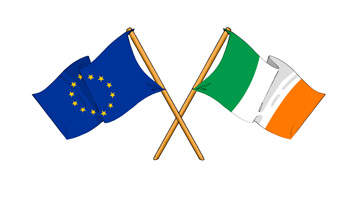
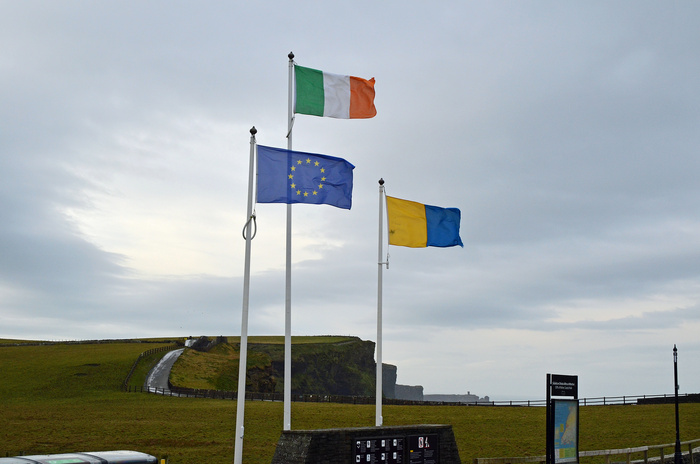
Photo: County Clare, Republic of Ireland and EU flags at the Cliffs of Moher
Republic of Ireland – background:
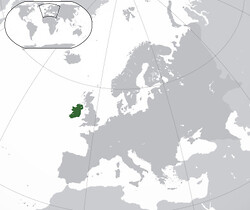

Ireland (Irish: Éire) is an island situated in the north Atlantic Ocean. It is separated from the UK to its east by the North Channel, the Irish Sea, the Celtic Sea and St George's Channel. It is the second largest island of the British Isles, the third largest in Europe and the 20th largest in the world. Geopolitically, Ireland is divided between the Republic of Ireland (officially named Ireland), which covers about 83% of the island and Northern Ireland which is part of the UK.
The geography of Ireland comprises relatively low-lying mountains surrounding a central plain with several navigable rivers extending inland. Its lush vegetation is a product of its mild but changeable climate which is free of extremes in temperature. Much of Ireland was woodland until the end of the Middle Ages. Today, woodland makes up about 10% of the island compared with a European average of over 33% and most of it is non-native conifer plantations.
The Irish climate is influenced by the Atlantic Ocean and thus very moderate. Winters are milder than expected for such a northerly area although summers are cooler than those in continental Europe. Rainfall and cloud cover are abundant.
The earliest evidence of human presence in Ireland is dated at 10,500 BC. Gaelic Ireland had emerged by the 1st century AD. The island was Christianised from the 5th century onward. Following the 12th century Norman invasion, England claimed sovereignty. However, English rule did not extend over the whole island until the 16th and 17th centuries Tudor conquest which led to colonisation by settlers from Britain. In the 1690s, a system of Protestant English rule was designed to materially disadvantage the Catholic majority and Protestant dissenters and was extended during the 18th century. With the Acts of Union in 1801, Ireland became a part of the UK. A war of independence in the early 20th century was followed by the partition of the island, creating the Irish Free State, which became increasingly sovereign over the following decades, and Northern Ireland, which remained a part of the UK.
The Republic of Ireland occupies 26 of the 32 counties of the island of Ireland. The capital and largest city is Dublin which is located on the eastern side of the island. Around a third of the country's population of 4.9 million people resides in the greater Dublin area. The Republic of Ireland shares its only land border with Northern Ireland and it is otherwise surrounded by the Atlantic Ocean to the west, the Celtic Sea to the south, St George's Channel to the south east and the Irish Sea to the east.
The Republic of Ireland is a unitary parliamentary republic. The legislature, the Oireachtas, consists of a lower house (Dáil Éireann), an upper house (Seanad Éireann) and an elected President (Uachtarán) who serves as the largely ceremonial head of state but with some important powers and duties. The head of government is the Taoiseach (Prime Minister, literally “Chief”, a title not used in English) who is elected by the Dáil and appointed by the President. The Taoiseach in turn appoints other government ministers.
The Republic of Ireland was created as the Irish Free State in 1922 as a result of the Anglo-Irish Treaty. It had the status of a Dominion, a semi-independent state within the British Empire, until 1937 when a new constitution was adopted in which the state was named "Ireland" and effectively became a republic with an elected non-executive president as head of state. It was officially declared a republic in 1949 following the Republic of Ireland Act 1948. The Republic of Ireland became a member of the United Nations in December 1955 and it joined the European Economic Community (EEC), the predecessor of the European Union (EU), in 1973.
The Republic of Ireland had no formal relations with Northern Ireland for most of the 20th century but during the 1980s and 1990s the British and Irish governments worked with the Northern Ireland parties towards a resolution to "The Troubles". Since the signing of the Good Friday Agreement in 1998, the Irish government and the Northern Ireland Executive have co-operated on a number of policy areas under the North-South Ministerial Council created by the Agreement.
The Republic of Ireland ranks among the top 10 wealthiest countries in the world in terms of GDP per capita and as the 10th most prosperous country in the world according to The Legatum Prosperity Index 2015.
After joining the EEC, the Republic of Ireland enacted a series of liberal economic policies that resulted in rapid economic growth. The country achieved considerable prosperity between the years of 1995 and 2007 which became known as the “Celtic Tiger” period. This was halted by an unprecedented financial crisis that began in 2008 in conjunction with the concurrent global economic crash. However, as the economy was one of the fastest growing in the EU in 2015, the Republic of Ireland again quickly ascended league tables comparing wealth and prosperity internationally.
In 2019, the Republic of Ireland was ranked the 3rd most developed country in the world by the United Nations Human Development Index which is a composite index of life expectancy, education and per capita income indicators. It also performs well in several national performance metrics including freedom of the press, economic freedom and civil liberties.
The Republic of Ireland is a member of the European Union and it is a founding member of the Council of Europe and the OECD. The Irish government has followed a policy of military neutrality through non-alignment since immediately prior to World War 2 and therefore the Republic of Ireland is consequently not a member of NATO although it is a member of Partnership for Peace (a NATO programme aimed at creating trust between NATO and other states in Europe and the former Soviet Union).
Primary target areas:
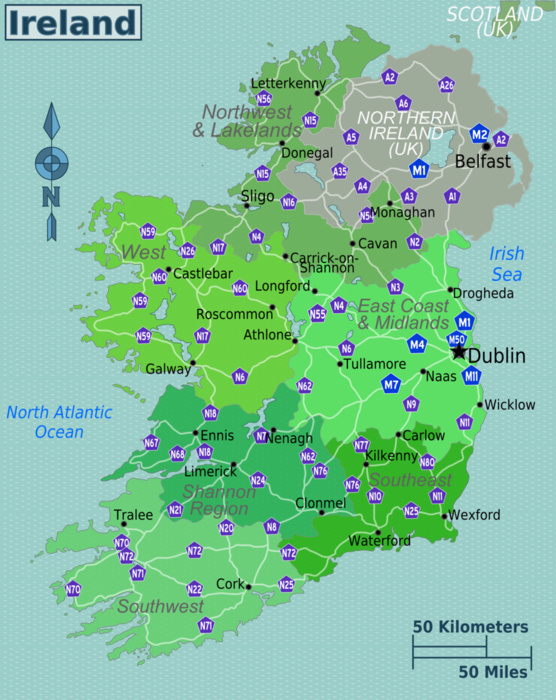
I undertook a route around the east and south coast of the Republic of Ireland from Dublin, my arrival point in the country.
The primary target areas for wildlife watching during my trip were:
County Wicklow
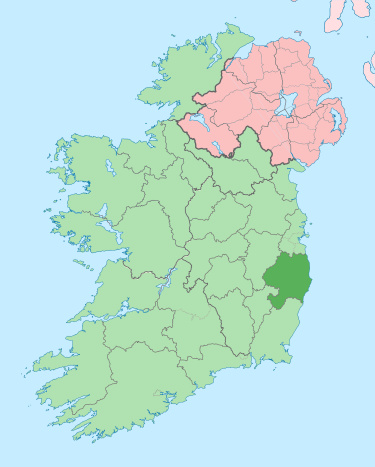
County Wicklow (Irish: Contae Chill Mhantáin) is part of the Mid East Region and also part of the traditional province of Leinster. It is the 17th largest of the Republic of Ireland's 32 counties by area and the 16th largest by population. The adjoining counties are County Wexford to the south, County Carlow to the south west, County Kildare to the west and County Dublin to the north.
County Wicklow is named after the town of Wicklow which derives from the Old Norse name Víkingaló meaning "Vikings' Meadow".
The Wicklow Mountains form the largest continuous upland region in the Republic of Ireland. The highest peak is Lugnaquilla at 3035 feet.
County Wicklow, colloquially known as "the Garden of Ireland", has been a popular tourist destination for many years due to its scenery, beaches, walking, hiking and climbing options and various attractions including the ruins of the monastic city of Glendalough, Wicklow Gaol and water-based activities on reservoirs and the coast.
The Wicklow Way is the oldest waymarked long-distance walking trail in the Republic of Ireland.
In County Wicklow, I principally focused on the following sites:
Kilcoole
East Coast Nature Reserve
Avoca.
County Wexford
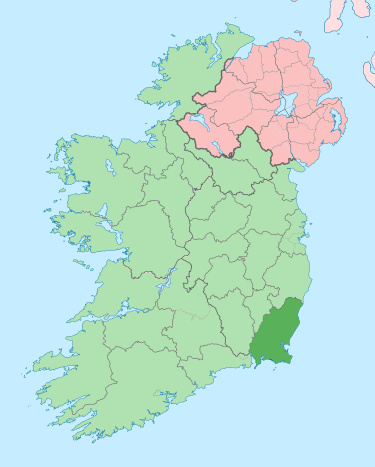
County Wexford (Irish: Contae Loch Garman) is part of the South East Region and also part of the traditional province of Leinster. It is the 13th largest of the Republic of Ireland's 32 counties by area and the 14th largest by population. It is located in the south east corner of the Republic of Ireland and bounded by the sea on 2 sides, to the south by the Atlantic Ocean and to the east by St. George's Channel and the Irish Sea. The River Barrow forms its western boundary. The Blackstairs Mountains form part of the boundary to the north as do the southern edges of the Wicklow Mountains. The adjoining counties are County Waterford to the south west, County Kilkenny to the west, County Carlow to the north west and County Wicklow to the north.
County Wexford is named after the town of Wexford and was based on the historic Gaelic territory of the dynasty of Hy Kinsella (Uí Ceinnsealaigh) whose capital was Ferns.
County Wexford is known as Ireland's "sunny south east" because, in general, the number of hours of sunshine received daily is higher than in the rest of the Republic of Ireland. This has resulted in County Wexford becoming one of the most popular places in the Republic of Ireland in which to live. It has a mild but changeable oceanic climate with few extremes.
In County Wexford, I principally focused on the following sites:
Wexford Harbour and Slobs including Wexford Wildfowl Reserve
Cahore Marsh
Curracloe Strand
Rosslare Bank Strand
Rosslare Harbour
Lady’s Island Lake
Tacumshin Lake
Kilmore Quay
Bannow Bay
Hook Head
County Waterford
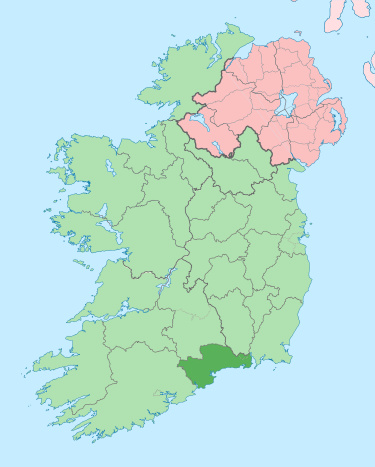
County Waterford (Irish: Contae Phort Láirge) is part of the South East Region and also part of the traditional province of Munster. It is the 20th largest of the Republic of Ireland's 32 counties by area and the 20th largest by population. County Waterford has 2 mountain ranges: the Knockmealdown Mountains and the Comeragh Mountains. The highest peak is Knockmealdown at 2605 feet. The adjoining counties are County Cork to the west, County Tipperary to the north west, County Kilkenny to the north east and County Wexford to the east.
County Waterford is named after the city of Waterford.
There are over 30 beaches along County Waterford's volcanic coastline and a large stretch of this, known as the “Copper Coast”, was designated as a European Geopark in 2001 and as a UNESCO Global Geopark in 2004 due to its geological importance.
In County Waterford, I principally focused on the following sites:
Waterford Harbour
Tramore Bay and Tramore Back Strand
Clonea
Dungarvan Bay
Helvick Head
County Cork
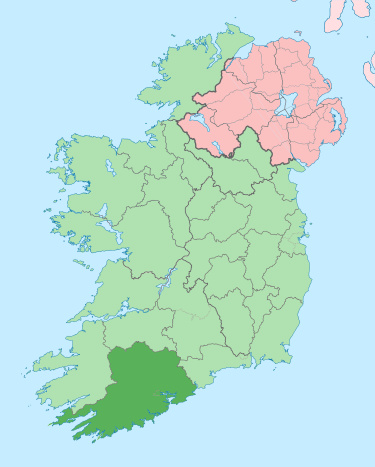
County Cork (Irish: Contae Chorcaí) is part of the South West Region and also part of the traditional province of Munster. It is the largest of the Republic of Ireland's 32 counties by area and the 3rd largest by population. The adjoining counties are County Kerry to the west, County Limerick to the north, County Tipperary to the north east and County Waterford to the east.
County Cork is named after the city of Cork, the Republic of Ireland's 2nd largest city.
In County Cork, I principally focused on the following sites (all in the extreme east):
Youghal Bay
Ballymacoda Bay
Ballycotton Bay
On my return to Dublin, I drove through County Kilkenny, County Carlow, County Kildare and County Meath (for the archaeological sites of Newgrange and Hill of Tara) but I did not stop at any specific sites for birding. In County Dublin, I did visit the Swords-Malahide estuary approximately 45 miles north of Dublin.
On my train trip from Dublin west to Galway, I travelled through County Laois, County Offaly, County Westmeath and County Galway. Only a few common species were seen from the train.
From Galway, I travelled by coach to the Cliffs of Moher. This beautiful route around Galway Bay, the coastline of County Galway and County Clare and through the The Burren did produce some notable window-spotted coastal species such as Red-throated Diver, Gannet, Wigeon, Curlew and Oystercatcher plus Redwing, Stonechat and Hooded Crow. At the Cliffs of Moher SPA, the cliff edges were already populated by Fulmars, Guillemots, Razorbills and Herring Gulls despite it still being only early February. Ravens were also evident.
Getting there:
Having taken 5 flights during 2019 plus several flights in previous years, I have made a conscious decision to not fly to or from European destinations in the future due to the adverse impact of flights on carbon emissions and the climate emergency. I will be writing more about this on my website.
I have supported “Flight Free 2020”. The Flight Free 2020 pledge is an international campaign encouraging people to fly less. It is currently active in the UK, Sweden, the Netherlands, Germany, Canada, the USA and Australia. Flight Free UK is part of the Stay Grounded Network which is running the Europe-wide "Let's Stay Grounded" campaign in 2020 and 2021.

There is no reason at all to fly to the Republic of Ireland and travelling by train and ferry is both enjoyable and cheap. Furthermore, it is estimated that travelling this way reduces CO2 emissions by around 70% to 75% compared with flying.
A cheap single “Rail and Sail” ticket between any rail station in the UK and any rail station in the Republic of Ireland includes both train and ferry travel. More information on “Rail and Sail” travel to/from the Republic of Ireland can be found at Mark Smith’s website, The Man in Seat 61 or at Irish Ferries.
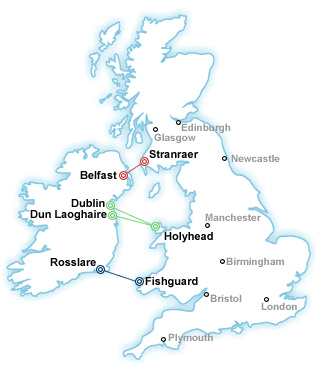
Map: "Rail and Sail" routes to/from the Republic of Ireland
For my return trip to Dublin, I used the rail service provided by Avanti West Coast and the ferry service provided by Irish Ferries.
The outward journey from my home town of Basildon to Dublin cost £50. Ignoring the Basildon to London leg, the schedule was as follows: depart London Euston 09:10 and arrive Holyhead Port 12:52, depart Holyhead Port 14:10 and arrive Dublin Ferryport 17:25
The return journey from Dublin to Basildon cost £44.50. Again, ignoring the London to Basildon leg, the schedule was as follows: depart Dublin Ferryport 08:05 and arrive Holyhead Port 11:20, depart Holyhead Port 12:53 and arrive London Euston 16:36
The train journey was particularly enjoyable between Chester and Bangor where it followed the north Wales coastline offering a different perspective of many locations that I have driven through or visited on previous trips to Wales, most notably Conwy and its well-preserved 13th century castle, Conwy RSPB reserve, the Snowdonia mountains and the Menai Strait.
The ferry journey provided an excellent view of the cliffs of South Stack RSPB reserve on Anglesey, a site that I have visited on an annual basis for many years, and a lovely winter evening sky over the Wicklow Mountains on the approach to Dublin Ferryport.
On both the outward and return ferry journey, there was a warning regarding moderate to rough seas but on both crossings there was only a very slight roll even though the Irish Sea did indeed look rather rough outside.
The W.B. Yeats ferry, named after the well-known Irish poet W.B. Yeats, is a large and modern ferry and proved to be an extremely relaxing way to cross the Irish Sea to Dublin.
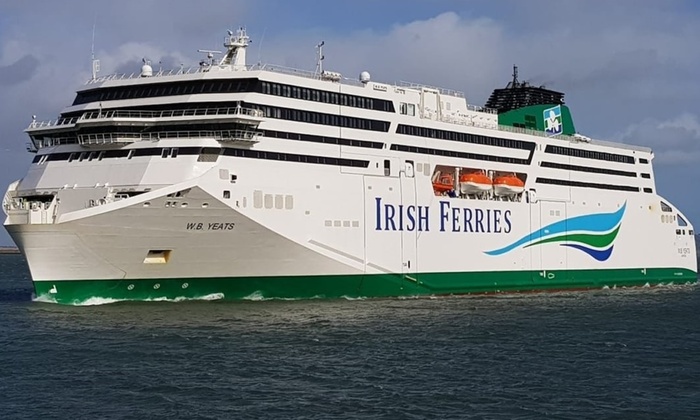
Photo: W.B. Yeats
Getting around:
On arrival at Dublin Ferryport, I took the bus provided by Morton’s Coaches to Dublin city centre and then the bus provided by Airlink Express to Dublin Airport. For my return journey, I took a taxi from my last night’s accommodation at Amberley House in Dublin city centre to Dublin Ferryport.
At Dublin Airport, I rented a Peugeot 208 for 7 days via Thrifty booked in advance. The cost of car rental was a mere 34.80 euros (£31.05), an amazingly low price which made me check the quote at least twice before booking! The only additional cost was 4 x 3.10 euros (£10.52) in respect of the expected M50 motorway tolls around Dublin which were recharged back to me after I returned the car.
The car proved to be reliable and economical. The cost of petrol in Ireland was broadly similar to the UK with Applegreen proving to be the cheapest.
During my trip around Ireland, I drove 870 km (540 miles). In and around Dublin, the roads were exceptionally busy and congested especially at peak times and including the C-shaped M50 orbital motorway around the city. However, outside Dublin and its immediate surrounding areas and in the mostly rural areas which I visited during the majority of my trip, the roads were generally quiet.
On 5th February 2020, I travelled by train from Dublin Heuston to Galway Ceantt. I returned on 6th February 2020. The railway stations are named after Seán Heuston and Éamonn Ceannt, both of whom were Irish republicans who took part in the Easter Rising in April 1916 and were subsequently executed by firing squad in Kilmainham Gaol in Dublin. I booked 2 single tickets for my return journey in advance via Irish Rail. The total booking cost was 35.98 euros (£30.70) but see below regarding enforced changes and additional costs to my return journey. The outward schedule was as follows: depart Dublin Heuston 7:35 a.m. and arrive Galway Ceantt 10:08 a.m. The return schedule was as follows: depart Galway Ceantt 5:20 p.m. and arrive Dublin Heuston 7:54 p.m. More information on train travel in the Republic of Ireland can be found at Mark Smith’s website, The Man in Seat 61.
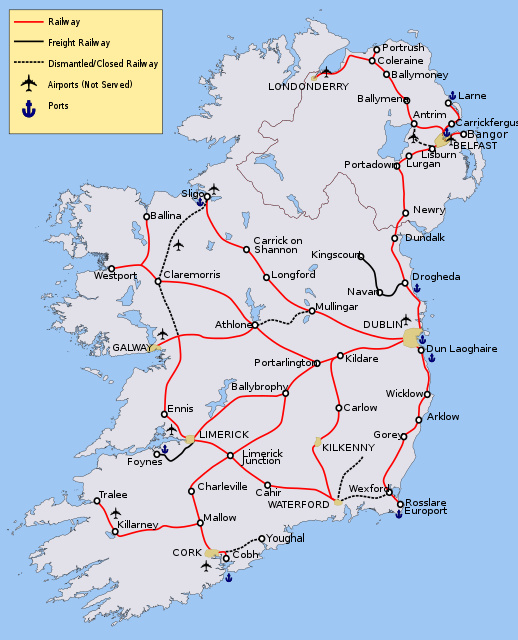
Map: Irish railway network
On 6th February 2020, I travelled by coach from Galway to the Cliffs of Moher. I booked a return journey in advance on service 350 via Bus Éireann.
The total booking cost was 25 euros (£21.23). The outward schedule was as follows: depart Galway bus station 8:00 a.m. and arrive Cliffs of Moher coach park 10:15 a.m. My planned return schedule was as follows: depart Cliffs of Moher coach park 11:20 a.m. and arrive Galway bus station 1:30 p.m. The return schedule would have enabled me to spend some more time in Galway before catching my return train to Dublin at 3:05 p.m. and using my non-flexible train ticket. However, despite going back to the Cliffs of Moher coach park in time for the arrival of the return coach at 11:20 a.m., the coach failed to stop despite me gesturing. As such, my return schedule was put back as follows: depart Cliffs of Moher coach park 1:20 p.m. and arrive Galway bus station 3:30 p.m. This resulted in me missing the 3.05 p.m. train to Dublin and I incurred an additional cost of 19.99 euros (£16.98) by having to buy another train ticket since my original return ticket was invalid.
As it turned out, the 2 hours additional time spent at the Cliffs of Moher allowed for further walks at this spectacular site plus the earlier cloudy/misty weather cleared to bright sunshine. Nonetheless, I submitted a complaint to Bus Éireann regarding my return journey together with additional issues in respect of their service i.e. the cold temperature on the coach, the smell on the bus, the absence of any wi-fi despite a notice saying it was available and the grumpy and uncommunicative driver. Eventually, after escalating my complaint, I received a full refund of my coach ticket which more than covered the cost of the additional train ticket. Given that I had been able to spend longer at the Cliffs of Moher than originally planned, this was a satisfactory outcome all round!
In Dublin, I travelled around the city largely by foot but I also used public transport. Dublin Bus and Luas provide excellent bus and tram services respectively. The easiest and most cost effective way of using public transport in Dublin is to buy a Leap Visitor Card.
Itinerary:
I travelled independently following thorough research and preparing an itinerary before leaving the UK.
28th January 2020: Basildon > London Euston > Holyhead Port > Dublin Ferryport > Dublin > Dublin Airport > pick up rental car > Dublin
29th January 2020: Dublin > Bray > Kilcoole > East Coast Nature Reserve > Avoca > Cahore Marsh > Wexford > Rosslare Strand
30th January 2020: Rosslare Strand > Rosslare Back Strand > Lady’s Island Lake > Wexford > Wexford Wildfowl Reserve > Curracloe Strand (Ballinesker) > Wexford > Rosslare Strand
31st January 2020: Rosslare Strand > Tacumshin > Kilmore Quay > Bannow Bay (Carrick, Wellingtonbridge and Tintern Bridge) > Hook Peninsula and Hook Head > Duncannon
1st February 2020: Duncannon > Ballyhack > Passage East Ferry > Passage East > Dunmore East > Tramore Bay and Tramore Back Strand (Saleen and Tramore) > Annestown > Boatstrand > Kilmurrin Cove > Dungarvan Bay (Barnawee Bridge and Ballynacourty Pier and Ballynacourty Point, Ballinclamper, Dungarvan and Helvick Head) > Helvick > Stradbally
2nd February 2020: Stradbally > Dungarvan Bay (Barnawee Bridge and Cunnigar) > Youghal Bay > Pilmore Strand > Ballycotton > Ballymacoda > Dungarvan Bay (Dungarvan) > Waterford > Kilkenny
3rd February 2020: Kilkenny > Newgrange > Hill of Tara > Swords > Malahide > Portmarnock > Dublin Airport > return rental car > Dublin
4th February 2020: Dublin
5th February 2020: Dublin Heuston > Galway Ceantt > Galway
6th February 2020: Galway > Cliffs of Moher > Galway > Galway Ceantt > Dublin Heuston > Dublin
7th February 2020: Dublin > Dublin Ferryport > Holyhead Port > London Euston > Basildon
Accommodation:
Prior to my trip, I had pre-booked the following accommodation either directly or via ebookers.com or booking.com.
28th January 2020: Dublin – No. 9 Rathgar by the Key Collections – 44 euros (£37.76) for 1 night
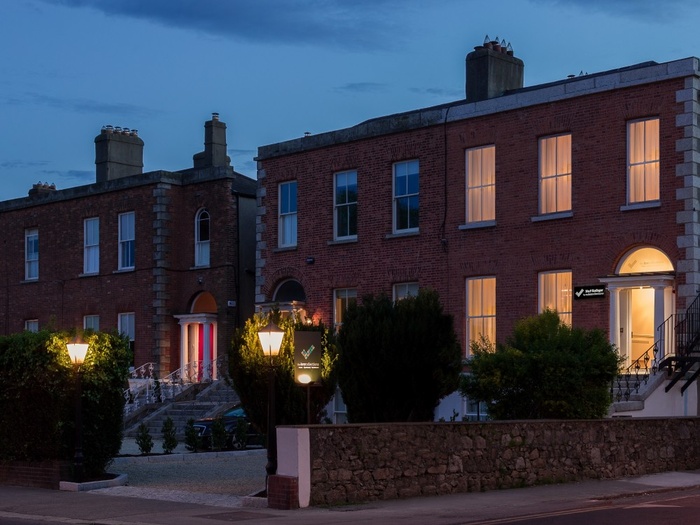
No. 9 Rathgar by the Key Collections is a beautiful 3 storey Georgian house located in the architectural conservation zone of Rathgar, a quiet residential suburb about 2 miles south east of Dublin city centre. One of the most famous residents of Rathgar was James Joyce, the Irish novelist, short story writer, poet, teacher and literary critic. Travel to and from the city centre is very easy using the frequent and regular buses which stop nearby. There is very limited on-site parking (although I found a space easily) but there is plenty of free on-street parking.
I received a very warm welcome from Carolina on reception and played “guess the nationality” which I lost after several incorrect guesses. Carolina is from Brazil but speaks perfect English.
Although a Georgian house, my room had been renovated and modernised and was spotlessly clean and decorated in shades of grey and white. The room contained a large and comfortable double bed, an en-suite shower and WC, a kettle and supply of tea, coffee and biscuits, a small fridge, a small safe, a TV and a desk and stool. There was a strong wi-fi reception in the room and throughout the accommodation.
No. 9 Rathgar by the Key Collections offers accommodation on a room only basis i.e. there is no breakfast or other meals. However, Carolina provided a map showing the location of restaurants, cafes and supermarkets within close walking distance. I had my evening meal at Lumanti of Nepal, a 10 minute walk from No. 9 Rathgar by the Key Collections. Lumanti had a nice atmosphere and friendly service and provided excellent Nepalese food at a cost of 29.90 euros (£26.34) although I was offered a free beer since they had forgotten to add my second to the bill.
No. 9 Rathgar by the Key Collections is highly recommended as value for money accommodation away from the noise of the city centre but with good neighbourhood services and transport links.
29th and 30th January 2020: Rosslare Strand, County Wexford – Coast Rosslare Strand – £86.43 for 2 nights
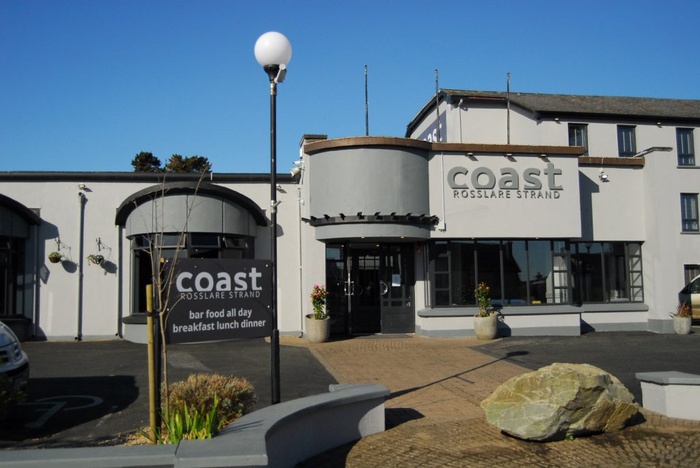
Coast Rosslare Strand is a large and modern hotel located in the coastal village of Rosslare Strand in County Wexford. The reception was friendly and the check-in was very quick.
The large room had a distinct marine feel with its dried grasses, shells and sea-themed paintings and contained a double bed, an en-suite bath and WC, a kettle and supply of tea and coffee, a TV and a desk and chair and a small table and chairs. There was a strong wi-fi reception in the room and throughout the accommodation. Although the main room was clean and comfortable enough, the bathroom had numerous patch repairs and decorations and was in desperate need of modernisation. In addition, the lighting in the main room was totally insufficient. There was no central ceiling light and lighting was therefore limited to a light over the desk and very poor bedside lighting. There were also very few power sockets and none at all by the bed other than one behind and below the bed itself.
The bar provided friendly service, excellent Guinness and a limited but very good menu including a daily special for a starter, main course and dessert. Evening meals (including a few pints of Guinness!) cost 36.90 euros (£31.27) and 39 euros (£33.09). On 29th January, I was also able to watch the Manchester derby in the second leg of the League Cup on the big screen in the bar.
I would stay at Coast Rosslare Strand again if visiting the area but hopefully they will improve the room in respect of the issues that I have mentioned.
31st January 2020: Duncannon, County Wexford – Seashells B&B – £39.61 for 1 night
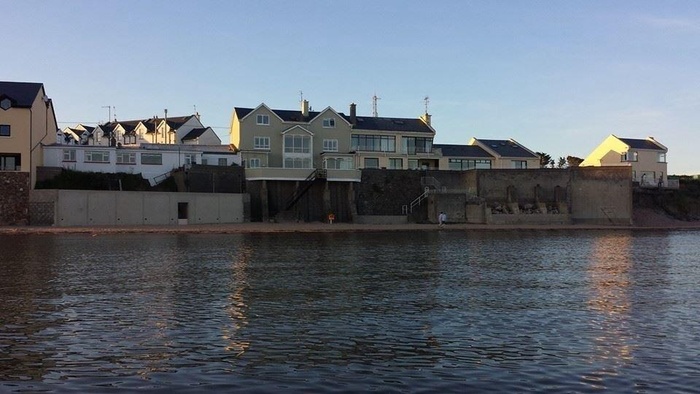
Seashells B&B is located in the small village of Duncannon in County Wexford and easily won the “view from the accommodation” award during my trip with its views of the long sandy beach, Waterford Harbour, the Hook peninsula and Hook Head.
It is a small 3 room bed and breakfast accommodation run by the very friendly Eric and Dympna. There is no on-site parking but the accommodation is situated in a quiet residential street with plenty of free on-street parking. The small room was spotlessly clean and contained a double bed, a small en-suite shower and WC plus an amazing view with the sound of the sea with the window open. The immediately adjacent communal lounge area (with the same view) contained a sofa, chairs, breakfast table, TV and a supply of tea, green tea, coffee, hot chocolate and biscuits. I was the only guest during my stay and therefore had the communal area to myself although I suspect that it could become a bit crowded if all rooms were occupied. There was a strong wi-fi reception in the room, in the communal area and throughout the accommodation. Breakfast was included in the nightly rate and was excellent.
No evening meals are provided and options in the village are basically limited to Roches Bar and Strand Tavern. I had an evening meal at the former, one of the oldest traditional bars in the area. The pub style food plus obligatory Guinness cost 29.85 euros (£25.18).
Seashells B&B is highly recommended when visiting the Hook peninsula and south west County Wexford and for onward travel via the Passage East ferry across Waterford Harbour in to County Waterford.
1st February 2020: Ballyvoile near Stradbally, County Waterford – Comergah View B&B – 50 euros (£43.62 including currency exchange fees) for 1 night
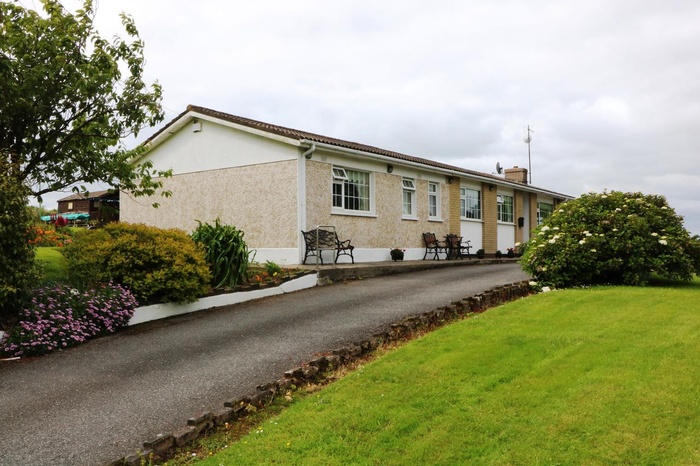
Comeragh View B&B is located in the small settlement of Ballyvoile near the village of Stradbally and 8 miles east of the coastal town of Dungarvan in County Waterford. Named after the Comeragh Mountains, it easily won the “accommodation hospitality” award during my trip.
It is a small bed and breakfast accommodation run by the exceptionally welcoming and friendly Maureen and Tony for 41 years! Whilst clearly sign-posted at 2 points off the R675 Tramore to Dungarvan road, it can be very difficult to find when it is dark. I found it easily enough when I arrived in daylight but it was somewhat more challenging when I returned after my evening meal in Dungarvan. When I arrived, Maureen provided tea, home-made cake, recommendations for evening meals in Dungarvan and a very interesting discussion on Brexit, the future of the UK monarchy and the election in the Republic of Ireland. The small room was very clean but a bit dated and the pink and violet décor would not be everyone’s choice (including mine). It contained a double bed, a small en-suite shower and WC, a small TV and a supply of tea, coffee, bottled water, biscuits, sweets and chocolates. Plenty of on-site parking was available. Breakfast, prepared by Tony, was included in the nightly rate and was superb.
The nearby town of Dungarvan provides a wide range of different options to eat but it was extremely busy on a Saturday night. I had my evening meal at Crew’s, a restaurant situated in a restored 16th century building previously used as a work house, a grain store and leather factory. The very young service staff were exceptional and the seafood meal costing 32.80 euros (£27.67) was excellent.
There are many accommodation options in the town of Dungarvan but Comeragh View B&B is highly recommended as a rural and therefore very quiet choice.
2nd February 2020: Kilkenny, County Kilkenny – Hotel Kilkenny – £70.24 for 1 night
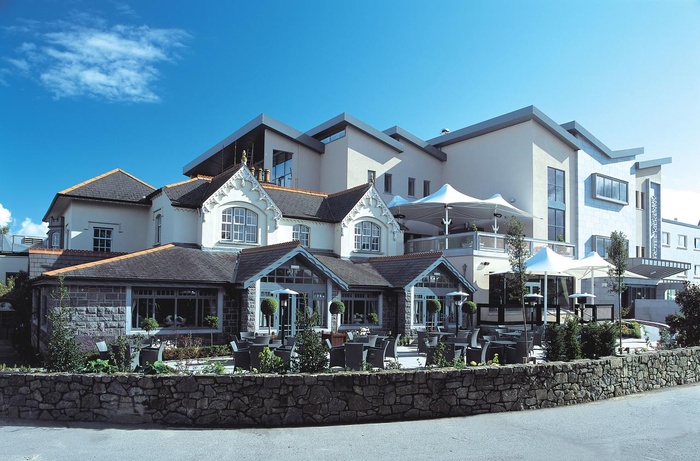
Hotel Kilkenny is located on the edge of the town of Kilkenny. I chose Kilkenny and this particular hotel since I wanted a stop-over roughly half way between County Cork and Dublin and an out-of-town hotel due to the many reviews of town centre hotels commenting on the noise.
Hotel Kilkenny is a 4 star large hotel and it was by far the most expensive accommodation during my trip. It was also the most disappointing by a long way. The basic room only rate with no breakfast offered very poor value for money even after allowing for my ebookers.com member’s discount and cashback. I have stayed in numerous refurbished Travelodges for half or even a third of the price and enjoyed a substantially better experience. The hotel exterior and large reception area probably does suggest a 4 star rating but the rooms, or at least the one that I stayed in, certainly did not. The large room contained a double bed with an en-suite bath and shower but the whole room required improvement and modernisation in terms of décor, furniture, fixtures and fittings. The room was also hot with no temperature control or air conditioning.
In addition, the restaurant appeared to be closed and the bar was extremely crowded due to the evening concert with Sharon Shannon, Mary Coughlan and Frances Black. Having finally found somewhere to sit, I had an evening meal. The service, despite it being so busy, was very good but the menu was very limited and not particularly interesting.
The highlight of my stay at Hotel Kilkenny was nothing to do with the accommodation but the brilliant concert (see more on this below).
Given the issues that I have detailed, I would not recommend Hotel Kilkenny and I would look at other accommodation options in or around Kilkenny if I visited again.
3rd and 4th February 2020: Dublin – No. 9 Rathgar by the Key Collections – 96.80 euros (£83.02) for 2 nights
Having stayed at No. 9 Rathgar by the Key Collections on the first night of my trip, I returned for a 2 night stay after returning my rental car (see above for my comments on this excellent accommodation).
Given that no meals are provided by the accommodation, I had my 2 evening meals at The Brazen Head in Dublin city centre and The Bijou in Rathgar. The Brazen Head is reputed to be the oldest pub in the Republic of Ireland. It was built as a coaching inn in 1754 on the site of a merchant's dwelling dating back to at least 1613. Local tradition claims that the site has housed a tavern or alehouse since 1198. Needless to say, it had loads of atmosphere and the huge portion of traditional Irish stew and obligatory 2 pints of Guinness at a cost of 22.30 euros (£19.04) was thoroughly enjoyable and good value for money. The Bijou is a bistro style restaurant and the excellent meal here from the “ daily set menu” with a glass of wine cost 27.55 euros (£23.52). My seat by the window also provided me with one of my trip records of Red Fox!
5th February 2020: Galway – The Nest – 61.20 euros (£54.11 including currency exchange fees) for 1 night
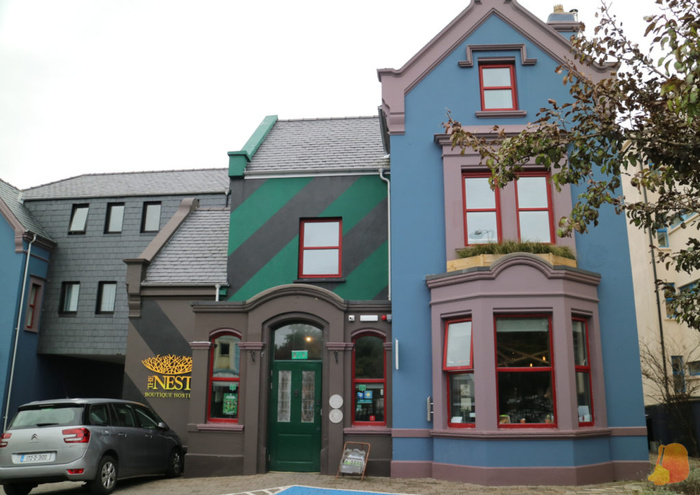
The Nest is located in the Salthill neighbourhood of Galway although easily connected to the city centre by the frequent and regular buses which stop nearby. It is described as a “boutique hostel” (what ever that is!) and includes both hostel type shared dormitory accommodation plus self-contained rooms. I received a very warm welcome from Mark on reception who dealt with check-in and explained the communal facilities.
The small room was rather basic and spartan. It contained a double bed, a small en-suite shower and WC and a small desk and chair. There was no TV or kettle and tea and coffee in the room although drinks were available in the communal area of the main building. Although the accommodation was clean, comfortable and quiet, I am not convinced that it was worthy of the nightly rate charged for it.
No evening meals are provided at The Nest but Galway offers numerous eating and drinking opportunities. I initially enjoyed a few pints of Guinness and some brilliant traditional Irish music at Tig Coili. Afterwards, I had my evening meal at The Piemaker, a tiny restaurant offering a range of home-made pies (there is a clue in the name!). The excellent meal including a glass of wine cost just 18.50 euros (£15.71).
Although I had no major issues with The Nest, I think I would probably look at other accommodation options in Galway if I visited again.
6th February 2020: Dublin – Amberley House by the Key Collections – 40.50 euros (£34.73) for 1 night
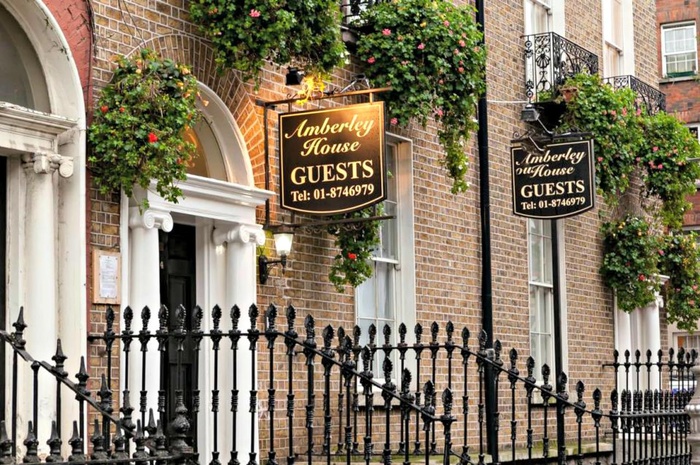
Amberley House by the Key Collections is a 3 storey Georgian house located on Lower Gardiner Street just north of Dublin city centre. I chose Amberley House by the Key Collections for the last night of my trip (rather than a further night’s stay at No. 9 Rathgar by the Key Collections) due to its much closer proximity to Dublin Ferryport for my return journey home.
However, it is situated on a main street with inevitable noise although fortunately my room was on the top floor so this was not particularly a problem. Having said that, a top floor room presented another problem since it had to be reached by several flights of stairs (no lift) carrying heavy luggage.
Although a Georgian house, my room had been renovated and modernised and was spotlessly clean although the sound-proofing left a lot to be desired. The room contained a double bed, a tiny en-suite shower and WC, a kettle and supply of tea, coffee and biscuits, a TV and a desk and chair. There was a strong wi-fi reception in the room and throughout the accommodation. Amberley House by the Key Collections offers accommodation on a room only basis i.e. there is no breakfast or other meals.
However, being in the city centre, there are numerous eating and drinking opportunities in close proximity. I had planned to eat at The Celt which is just a few minutes walk from Amberley House by the Key Collections and offers pub food and traditional Irish music. However, it was bursting and there was nowhere to sit. Therefore, I had my evening meal at O’Sheas which was even closer to my accommodation. This larger pub also had live music (Bono and The Edge from U2 and the late Phil Lynott from Thin Lizzy have played there in years past) and a large portion of traditional Irish stew and obligatory 2 pints of Guinness at a cost of 24.95 euros (£16.98) was thoroughly enjoyable and good value for money.
Amberley House by the Key Collections is recommended as value for money accommodation for a 1 night stay and as a location for travel to/from Dublin Ferryport. However, if I stayed in Dublin again for more than 1 night, I would definitely book the much quieter No. 9 Rathgar by the Key Collections which, whilst being outside the city centre, does have excellent transport links to it.
Research and planning:
Prior to my trip, I had undertaken a significant amount of research and planning and therefore had a detailed itinerary which I largely kept to other than a few variations.
In addition to a few Internet trip reports provided by others, my main source of information was ”Finding Birds in Ireland: The Complete Guide” by Eric Dempsey and Michael O’Clery. This comprehensive book covers almost 450 of the best birding sites in both Ireland and Northern Ireland. Organised county by county, it is an excellent handbook and provides grid references, detailed directions and maps for each site. It includes the best times to visit each site and a breakdown of the different seasons and the likely species to be seen. It also lists rare birds previously recorded at each site. It is highly recommended and it was particularly helpful in planning my itinerary around Ireland.
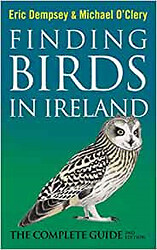
The following websites and Twitter accounts also proved to be valuable sources of information:
BirdWatch Ireland
Waterford Birds
BirdWatch Ireland – Cork Branch
East Coast Bird News
Wexford Bird News
Waterford Birds
Cork Bird News
In addition, I found “Lonely Planet: Ireland” to be invaluable in terms of both pre-planning my itinerary and particularly as a guide to the cities of Dublin and Galway. This book follows the usual Lonely Planet format and provides essential planning information, detailed information on a region by region basis plus a wide variety of other contextual information.
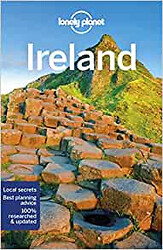
I also used an AA Road Atlas covering Ireland (a very old 2004 edition which presumably I had bought many years ago for a trip to Ireland) in addition to my trusty TomTom satnav.
Impressions, experiences and memories:
Wildlife:
I have detailed more on wildlife sightings below but in general terms the Republic of Ireland proved to be a superb winter birding destination.
Republic of Ireland:
This was my first trip to the Republic of Ireland and it was a strange experience in some ways. I was in a “foreign country” as evidenced by the currency being Euros and the road signs and directions being in kilometres yet, as in the UK, everyone speaks English and vehicles drive on the left.
Whilst I did not travel throughout the Republic of Ireland, the country is stunningly beautiful from the green rural areas to the sandy beaches to the awesome Atlantic Ocean, Celtic Sea and Irish Sea to the stupendous Cliffs of Moher.
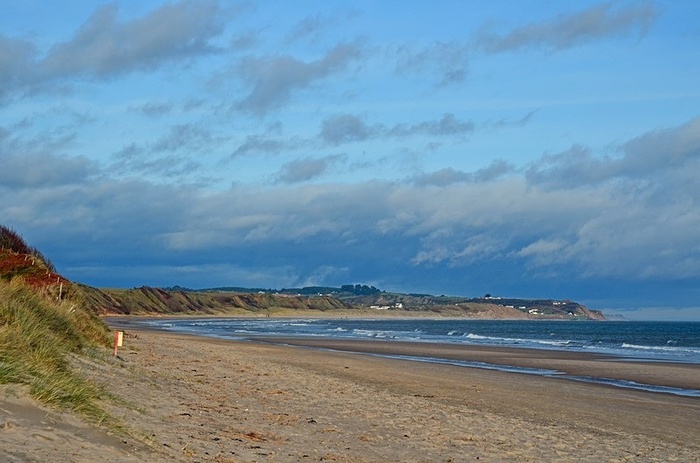
Photo: Curracloe Strand (Balinesker), County Wexford
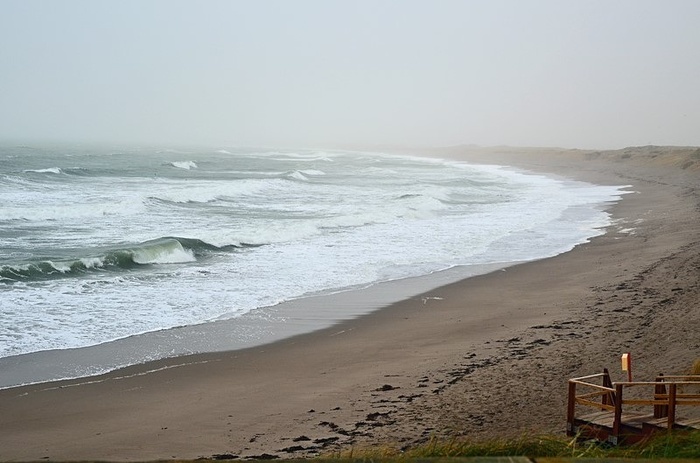
Photo: Ballyteige Strand, Kilmore Quay, County Wexford
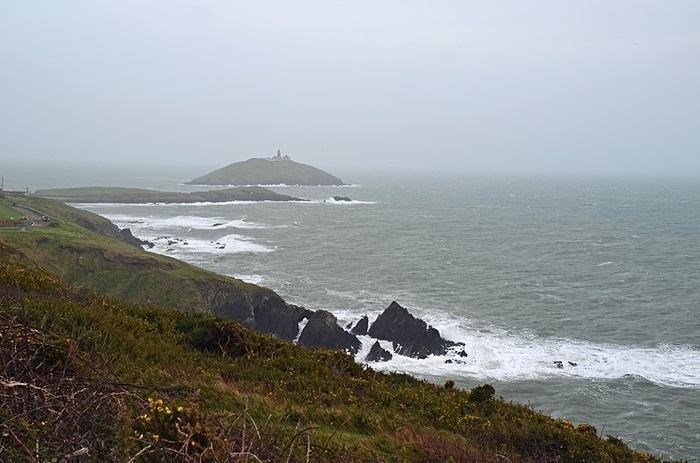
Photo: Ballycotton cliffs and Ballycotton Island, County Cork
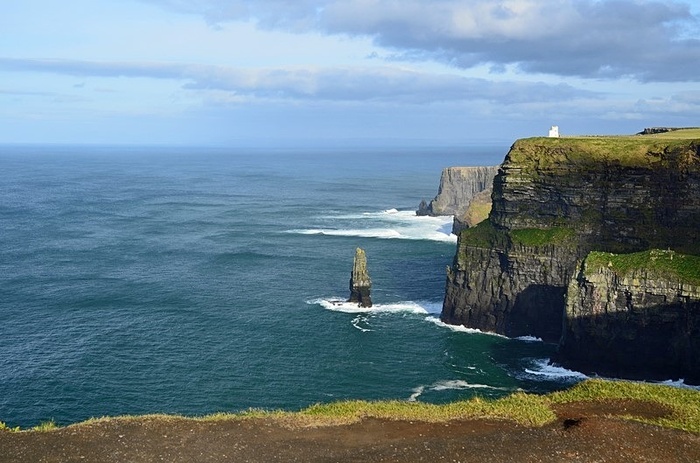
Photo: Cliffs of Moher, County Clare
I was also able to visit the 2 world famous and hugely interesting archaeological sites of Newgrange and Hill of Tara (see below for more information).
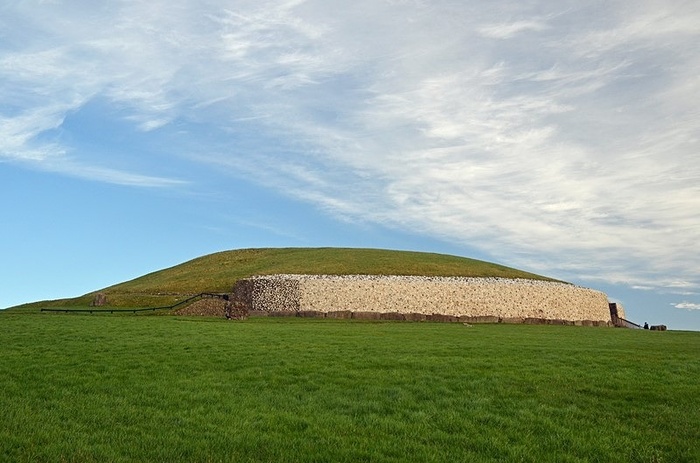
Photo: Newgrange, Brú na Bóinne, County Meath
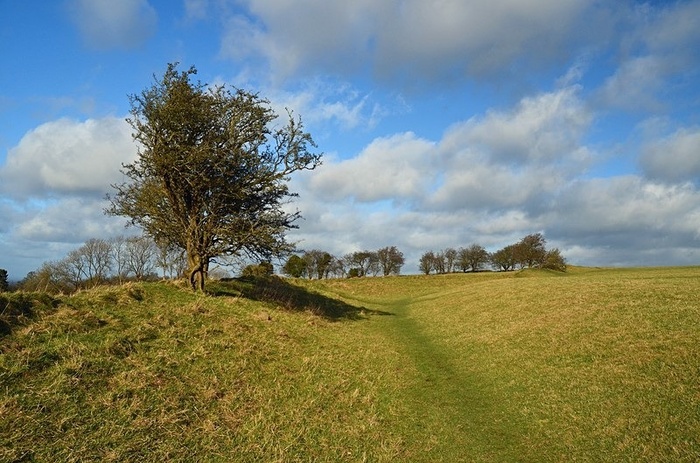
Photo: Hill of Tara, Tara-Skryne valley, Co.Meath
The Irish people:
It is said that there are only 2 types of people in this world: the Irish and those who want to be Irish. The friendliness and hospitality that I encountered was second to none and I have travelled extensively throughout western and eastern Europe. In my experience, you will not find a nicer group of people on this planet. Everywhere I went, I met friendly and interesting people who went out of their way to make me feel welcome in their country. Of course, the Guinness and traditional music didn't hurt either.
There is a passion and patriotism to the Irish people that seems very different from that in the UK. This is well demonstrated in ”Ireland’s Call”, an anthem commissioned by the Irish Rugby Football Union (IRFU) for the World Cup in 1995 and now sung at many sporting events but still most notably prior to matches played by the Irish rugby union team.
“Ireland’s Call” is so rousing, an anthem for everyone, whether in the south or the north of the island.
Maybe I am biased, being both a republican and an atheist for many years, but the UK national anthem, that interminable turgid “God save the Queen”, is an anthem to one person with huge privileges and an anthem inflated with imperial self-regard and breathless entitlement.
Music:
The Republic of Ireland is a country of wonderful traditional and other music.
Very fortunately, my trip coincided with a concert at Hotel Kilkenny (where I was staying) with Sharon Shannon, Mary Coughlan and Frances Black. All 3 performed solo sets with their respective bands before playing and singing together at the end.
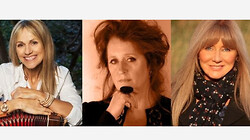
I have followed Sharon Shannon’s career for many years and I have most of her albums in my collection. Her performance was as brilliant as I expected it to be.
Frances Black is not only an Irish folk singer but she was also elected to Seanad Éireann as an independent senator in 2016. I knew a little about Frances Black before seeing her in Kilkenny and her performance of mainly ballads was excellent.
Mary Coughlan had a chequered and traumatic time in her younger life but has become the greatest Irish female vocalist. Blues, jazz, Irish soul …. what a voice! …. what a personality! I was so impressed that I tried to book a ticket for her show at Ronnie Scott’s in London in April 2020 but they all sold out instantly.
In addition to this concert, there were numerous opportunities to listen to Irish traditional music in the pubs which I made a point of visiting. Music-orientated pubs seem to be fairly similar i.e. dimly lit, wooden or tiled floors, numerous pictures and photos on the walls of musicians and a dedicated “please keep free for the musicians” area. Musicians and their various instruments (fiddles, whistles, uilleann pipes, button accordions, bodhrans, mandolins, guitars, etc.) seem to vary in number and variety throughout a session as people come and go. The whole experience is very atmospheric and thoroughly enjoyable especially if accompanied by Guinness!
The 3 most enjoyable pubs were The Temple Bar and The Cobblestone in Dublin and especially the Tig Cóilí in Galway.
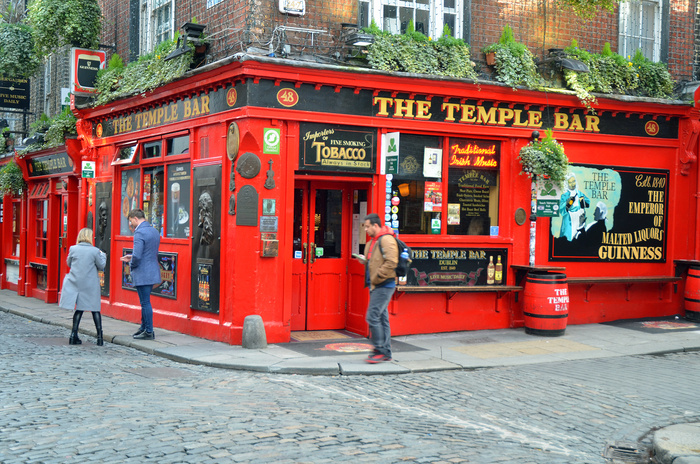
Photo: The Temple Bar, Dublin
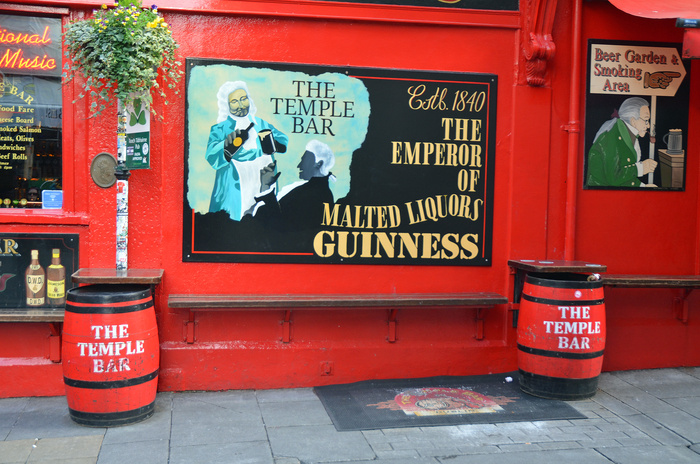
Photo: The Temple Bar, Dublin
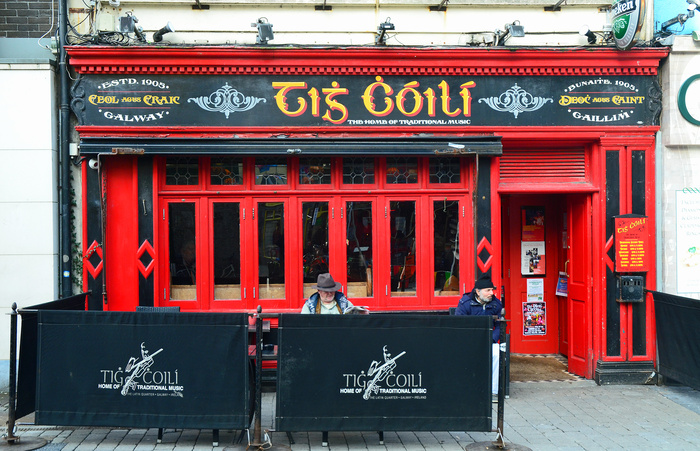
Photo: Tig Cóilí, Galway
Traditional Irish music at Tig Cóilí in Galway
Traditional Irish music at The Cobblestone, Dublin
Guinness:
When in the Republic of Ireland, it would have been amiss not to partake of the odd pint of Guinness. I had no difficulty at all in finding the wonderful black stuff or drinking it!. I also quickly learnt that patience is a virtue …. it takes ages for your pint of Guinness to be correctly poured and settle.
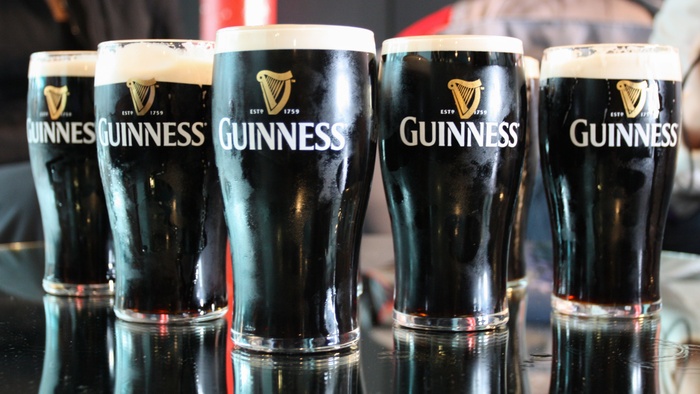
Line them up :-)
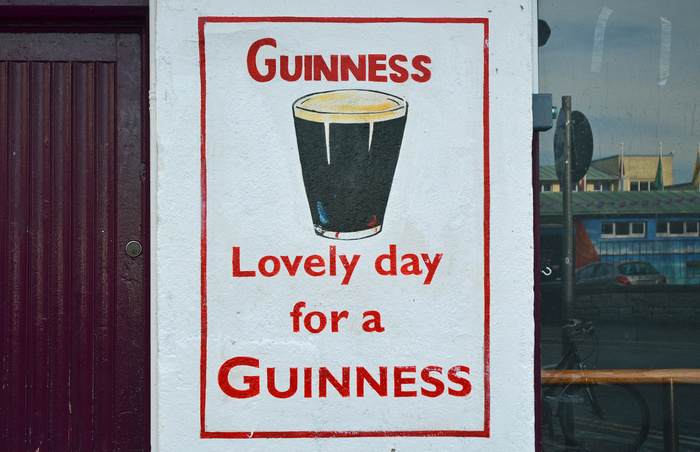
It is ALWAYS a lovely day for a Guinness :-)
Whilst in Dublin, it would also have been very disrespectful not to have visited the Guinness Storehouse where the stuff is made. Therefore, my brief stay in Dublin did include this on my itinerary (see below for more information).
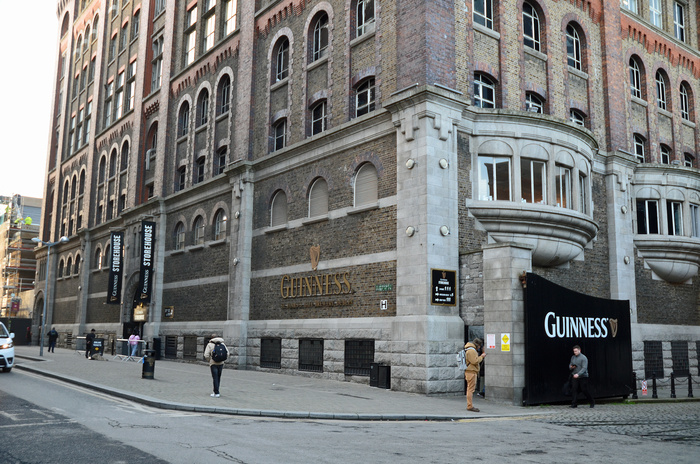
Photo: Guinness Storehouse, Dublin
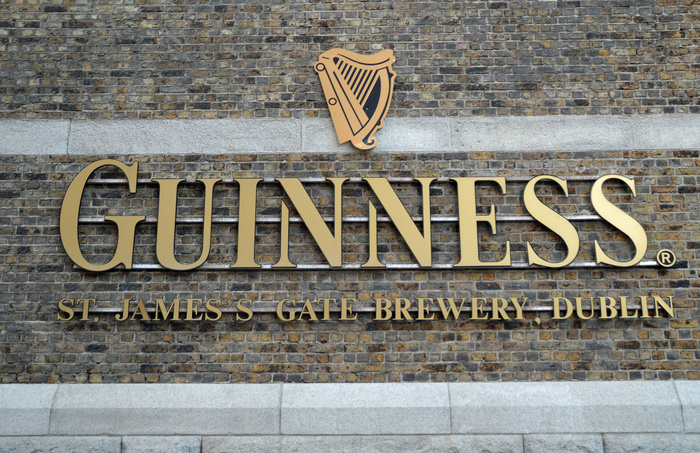
Photo: Guinness Storehouse, Dublin
General election:
When I arrived in Dublin, it very quickly became apparent that campaigning for the 2020 election was well underway with posters of the candidates of the different parties to be seen absolutely everywhere. This became a recurring theme where ever I travelled in the Republic of Ireland including in the most remote rural and coastal communities.
I did listen to one of the election debates on TV between the 3 main parties of Fine Gael, Fianna Fáil and Sinn Féin and it struck me that there was a far more constructive and respectful tone than that in the debates during the last UK general election in December 2019.
The actual election in the Republic of Ireland took place on Saturday 8th February 2020, a few days after I returned home, resulting in an almost 3-way tie and consequently an inconclusive outcome requiring some lengthy post-election negotiations as to who would form the next Government.
Brexit:
Since this was a self-designated "Bollocks to Brexit" trip in a bid to avoid ”Brexit Day” at home in the UK, I found myself in the strange position of leaving Holyhead in the UK and arriving in Dublin in the Republic of Ireland as an EU citizen but returning to the UK as a non-EU citizen.
What follows are my own personal views (albeit shared by many millions of people in the UK and across Europe) and I make no apology for expressing them on my own personal website. Any reader of this trip report has the right to agree or disagree.
It is frequently stated by the advocates of Brexit that the 2016 referendum was a demonstration of the “will of the people”.
In that referendum, 17,410,742 or 51.89% voted “leave”. This is factually correct. However, this represents just 26.8% of the UK population, taking in to account “remain” voters, those who did not vote and those not on the electoral register for various reasons. Even if those not on the electoral register are excluded, the “leave” vote represents just 37.4% of those eligible to vote. This is demonstrably not an overwhelming expression of “the will of the people”.
Furthermore, how can anyone respect a referendum outcome of 37% “leave” when it arose from false promises, lies, fraud and crime and a deliberately restricted electoral franchise? How can such a clear minority of the UK population be allowed to risk the prosperity, freedoms, rights and sovereignty of our country?
Since July 2017, only 8 out of 300 opinion polls showed “leave” ahead and only 1 out of 74 opinion polls had “leave” ahead in 2019.
In the general election in December 2019, only 47% voted for pro-Brexit parties.
The almost 4 years since the referendum in 2016 has shown Europe and the EU at their inclusive and tolerant best and the UK, and most notably England, at its rude, arrogant, superior, nationalistic and xenophobic worst. It is still hard to believe so many people swallowed the lies and smears.
Yet, despite and not because of “the will of the people”, the UK finally left the EU on 31st January 2020.
This is the most pointless, mean-spirited, ignorant and self-destructive project ever dreamed of in the history of the UK. It is a small-minded nationalistic project to remove the UK from a European partnership and community that has enriched our lives but made "little Englanders" feel insecure.
The rest of the world must piss themselves laughing at the UK, assuming that they pay any attention at all to such a shambolic shitshow of a country.
The EU was our best hope for an open, tolerant, free and peaceful community of nations. Summon up everything you have learned of the ruinous and desperate state of Europe in 1945 and then contemplate the economic, political and cultural achievement since that time: peace, open borders, economic prosperity and the encouragement of individual rights, tolerance and freedom of expression.
Until 31st January 2020, Europe was where UK citizens freely went at will to travel, live, work, study and love.
Take a road trip across and around Europe. Leave your passport behind. What a rich group of civilisations …. in language, culture, politics, religion, music, art, architecture, food, wine, sport and so much more. Each nation state profoundly and proudly different from its neighbours.
I didn’t vote in June 2016 to be a tourist requiring a visa as a citizen of a non-EU country. I wanted to continue being a European citizen. I wanted to be a true “cosmopolitan”, as envisaged by Diogenes, who coined the term. “Cosmopolitan” derives from the Ancient Greek: κοσμοπολίτης or kosmopolitês, formed from κόσμος or kosmos, meaning "world", "universe" or "cosmos" and πολίτης or politês", meaning "citizen" or "of a city". Contemporary usage defines the term as "citizen of the world".
For me, to be European is existential. It is about who and what we are. It defines a modus vivendi. It is a state of curiosity and a burning desire to learn about the way other people live.
I never travel to “holiday” in Europe but to conjoin European life. I have travelled to the far corners of Europe: from Galway in the Republic of Ireland in the far west to Reykjavík in Iceland in the far north west, to the Varanger peninsula in Finnmark in Norway in the far north, to the Black Sea coast in Bulgaria in the far east, to Crete and Cyprus in the far south east and to Tarifa in Andalucia in Spain in the far south west. I have seen, learnt and enjoyed so much in Europe.
My passport is British and I have British nationality. You can take the words off my passport and remove the stars from my driving licence but I will always be European.
We have been taken away from our friends, our allies and a magnificent cause by a vocal minority of the economically illiterate and the right-wing ideologues. Millions of us will never forgive nor forget.
I never wanted to see this happen but I have to accept that it has happened (at least for now).
I really hope it will not be what I think it will be. I will be the first one to say I am sorry if I am wrong but the signs for the future of our society and our economy do not augur well.
The campaign to “resist and rejoin” started at 11:00 p.m. on 31st January 2020. We will return. In the meantime Europe, this is our star. Look after it for us.
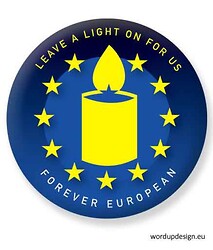
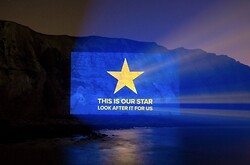
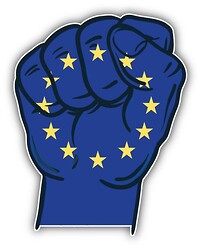
Weather:
The weather was very mixed and reminded me of my trips to west and north Scotland.
The first part of my trip when I had the rental car were characterised by sunny and bright spells interspersed with cloudy periods and light rain or even heavy rain. The periods of rain were not a great inconvenience since much of my birding was done by scanning and watching from the car or from hides in order to avoid disturbance to the flocks of geese, ducks, waders and other birds. Sea mist was also evident on some days.
For my last day with the rental car, when I visited the archaeological sites of Newgrange and Hill of Tara, it was sunny and dry all day as it was when I was in Dublin and Galway after returning the rental car.
My final full day, when I visited the Cliffs of Moher, was initially cloudy but then sunny for the remainder of the day from mid-morning.
Daily temperatures ranged from 5°C to 13°C during the first part of my trip but from 3°C to 9°C whilst in Dublin and Galway with an early morning low of -1°C whilst waiting at Galway bus station for the coach to the Cliffs of Moher.
Wildlife highlights:
During my trip, I was able to record 91 species of birds and 2 species of mammals.
Trip list
Of the 91 species of birds, 6 species would have been additions to my 2020 UK list if the Republic of Ireland was part of the UK …. it isn’t so they aren’t!
These are the 6 species:
Greater (Greenland) White-fronted Goose
Pale-bellied Brent Goose
Hen Harrier
Bonaparte’s Gull
Rock Pipit
Black Redstart
The undoubted highlight amongst my bird records for this trip was my second ever sighting of a Bonaparte’s Gull at Kilmore Quay in County Wexford (my first sighting was at Oare Marshes in Kent in September 2019). The Bonaparte's Gull breeds in boreal forest across southern Alaska and much of interior western Canada as far east as central Quebec and south to within 200 miles of the United States/Canada border. It winters along the coasts of north America and in the Great Lakes region of Canada and the United States. It is a rare vagrant to western Europe where it generally associates with Black-headed Gulls. The bird at Kilmore Quay had been reported off the piers since mid-November 2019 so I was reasonably confident when planning my trip of being able to see it. Nonetheless it took a while to track it down amongst the Black-headed Gulls given the strong winds and stormy sea.
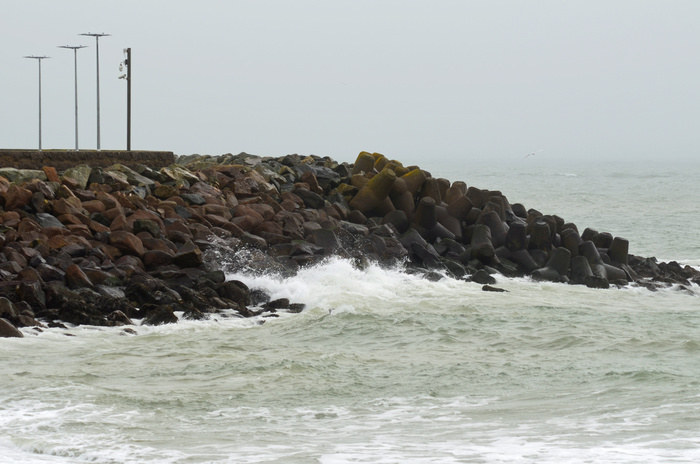
Photo: Kilmore Quay, County Wexford …. there is a Bonaparte's Gull here somewhere!
The large numbers of Greater (Greenland) White-fronted Geese and Pale-bellied Brent Geese (compared with the Greater (Russian) White-fronted Geese and Dark-bellied Brent Geese that I familiar with in East Anglia) were also memorable.
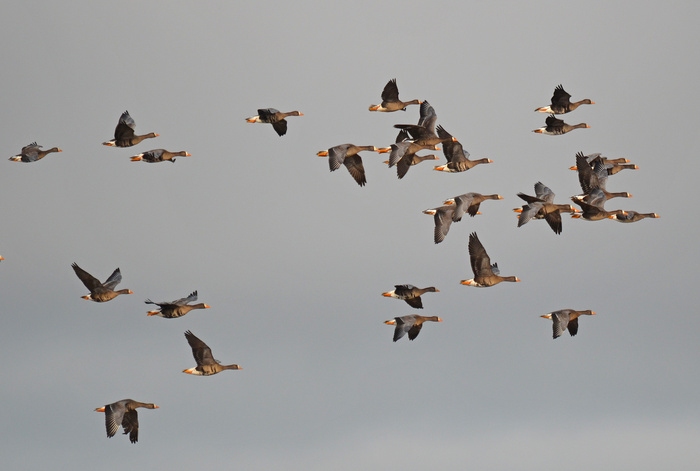
Photo: Greater (Greenland) White-fronted Geese at Wexford Wildfowl Nature Reserve, County Wexford
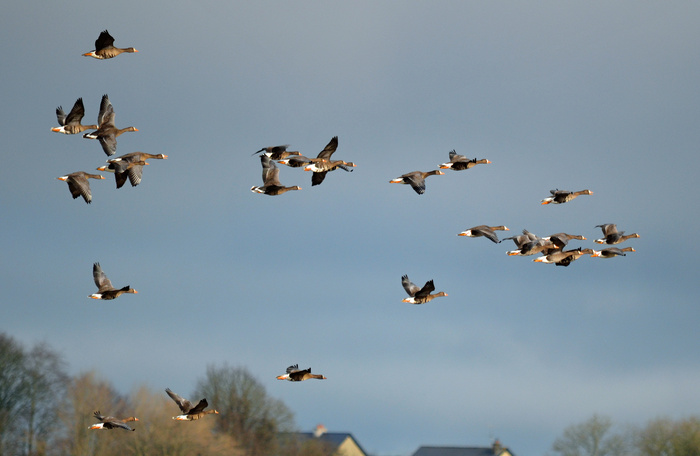
Photo: Greater (Greenland) White-fronted Geese at Wexford Wildfowl Nature Reserve, County Wexford
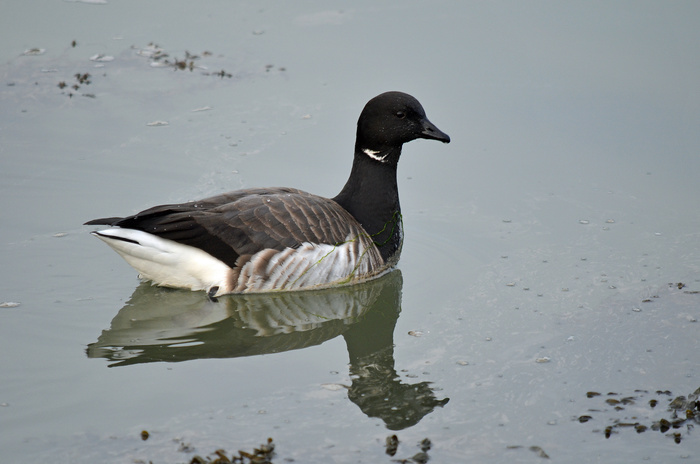
Pale-bellied Brent Goose at Barnawee Bridge, Dungarvan, County Waterford
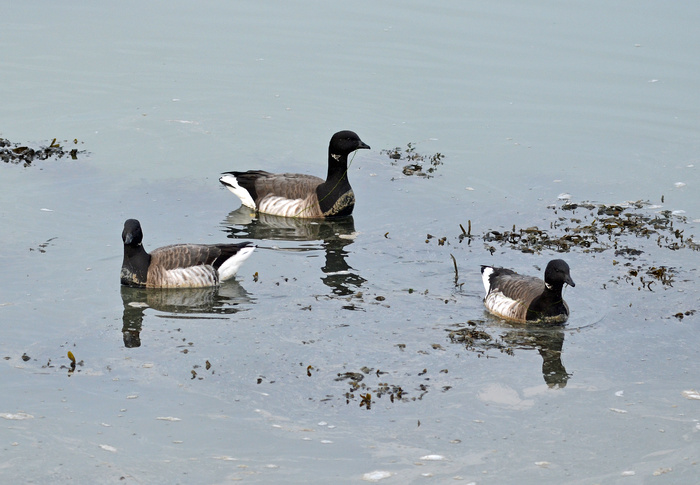
Pale-bellied Brent Geese at Barnawee Bridge, Dungarvan, County Waterford
During my trip, I was only able to record the following mammals: Red Fox and Rabbit.
Disappointments:
As far as birds are concerned, the main disappointment was not seeing 2 other long-staying north American rarities: a Green-winged Teal at East Coast Nature Reserve in County Wicklow and a Long-billed Dowitcher at Tacumshin in County Wexford. However, I have previously recorded both these species in the UK: Green-winged Teal on 5 occasions, most recently at WWT Caerlaverock in Dumfries and Galloway in January 2016 and Long-billed Dowitcher on 6 occasions, most recently at RSPB Bowling Green Marsh in Devon in January 2020 and just prior to my trip to the Republic of Ireland.
In addition, there were several other species that I had expected or hoped to see during my trip but which I failed to record. The most notable of these was Red-billed Chough. Despite extensive searching at well-known coastal and cliff-top sites and at other apparently suitable sites, I failed to see this locally common bird of the south and west of the Republic of Ireland.
The low number of mammal species recorded (just Red Fox and Rabbit) was disappointing in its own right but I was particularly disappointed not to see Irish Hare at Wexford Wildfowl Reserve or on other suitable lowland pastures, coastal grasslands and salt marshes in County Wicklow and County Wexford.
The non-wildlife bit:
In addition to wildlife watching, my trip also included visits to the cities of Dublin and Galway, the archaeological sites of Newgrange and Hill of Tara in County Meath and the Cliffs of Moher in County Clare.
Dublin:
Dublin is the capital and largest city of the Republic of Ireland. It is situated on a bay on the east coast at the mouth of the River Liffey and it is bordered to the south by the Dublin Mountains, a part of the Wicklow Mountains range. There is archaeological debate regarding precisely where Dublin was established by the Gaels in or before the 7th century. Later expanded as a Viking settlement, the Kingdom of Dublin, the city became Ireland's principal settlement following the Norman invasion. The city expanded rapidly from the 17th century and was briefly the second largest city in the British Empire before the Acts of Union in 1800. Following the partition of Ireland in 1922, Dublin became the capital of the Irish Free State and subsequently the Republic of Ireland.
I only had one full day allocated to sightseeing in Dublin during my trip and therefore I planned an itinerary in advance, partly walking and partly using the buses and trams.
The following websites provided useful information to assist planning:
Visit Dublin
Ireland – Dublin
My itinerary included the following visitor attractions, all of which are highly recommended:
Trinity College: Book of Kells and the Old Library: Unfortunately, due to conservation works, the incredibly beautiful Book of Kells was removed from public display in November 2019 until February 2020 inclusive. However, a full colour replica and associated exhibition were available to the public, as was the amazing Old Library.
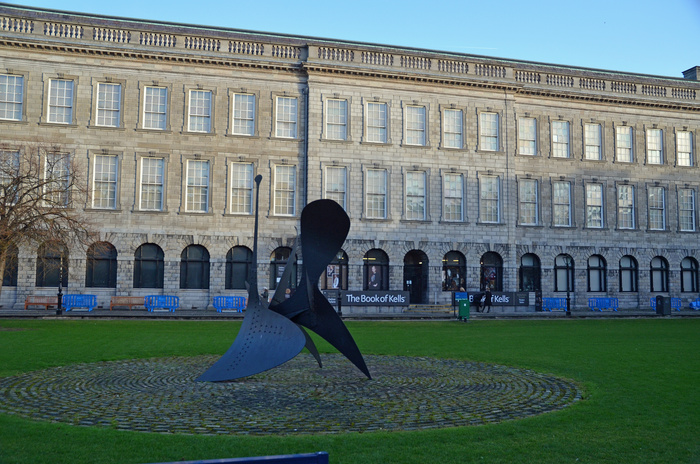
Photo: Trinity College, Dublin
GPO Witness History: This permanent exhibition focusing on the 1916 Easter Rising is located in the iconic and historical General Post Office in O’Connell Street. I found it to be immensely interesting and informative in understanding the 20th century history of Ireland.
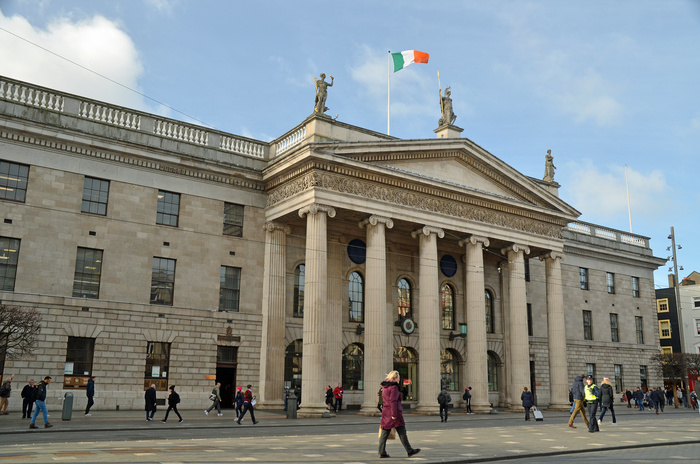
Photo: General Post Office, O’Connell Street, Dublin
Guinness Storehouse: Guinness is synonymous with Ireland and no visit to Dublin is complete without a trip to the Guinness Storehouse, the home of Guinness and the number one international visitor attraction. Located in the heart of the legendary St. James’s Gate Brewery in Dublin, this production site has been home to the Guinness Brewery since 1759 when Arthur Guinness signed a lease for 9000 years. The Guinness Storehouse building dates back to 1904 was once the fermentation plant of the brewery. It is now a 7 storey visitor experience (shaped around a giant pint which, if filled, would contain 14.3 million pints of Guinness) dedicated to the history of the making of Guinness. The highlight for many visitors is the Gravity Bar, symbolically the “Head of the Pint”, where unparalleled panoramic views of Dublin city can be enjoyed …. with a complimentary pint of Guinness in hand.
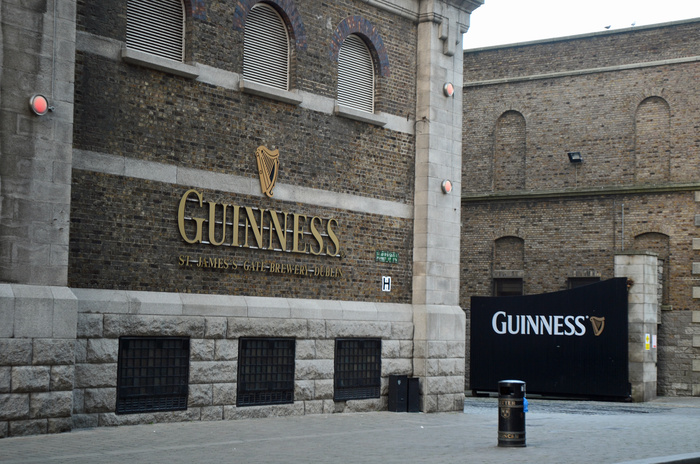
Photo: Guinness Storehouse, Dublin
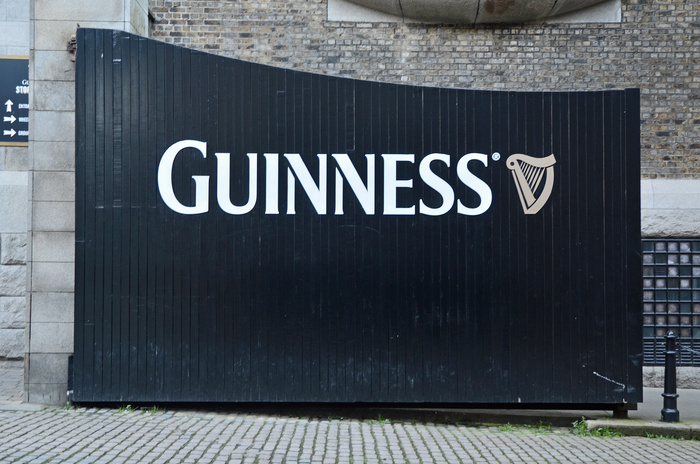
Photo: Guinness Storehouse, Dublin
In addition to the above, my walking itinerary took me past the following:
Ha’penny Bridge: Officially known as the Liffey Bridge, the Ha’penny Bridge is a pedestrian bridge built in May 1816 over the River Liffey. Before it was built, there were 7 ferries, operated by a William Walsh, across the River Liffey. The ferries were in a bad condition and Walsh was informed that he had to either fix them or build a bridge. Walsh chose the latter option and was granted the right to extract a ha'penny toll from anyone crossing it for 100 years. The toll was increased for a time to a penny-ha'penny but was eventually dropped in 1919.
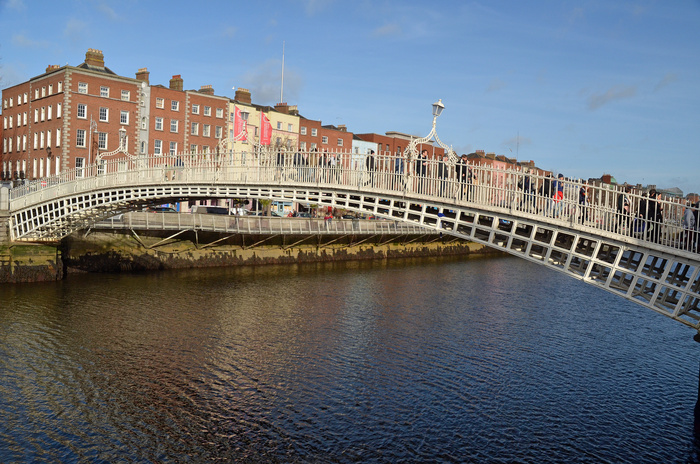
Photo: Ha’penny Bridge and River Liffey, Dublin
St. Patrick’s Cathedral: Built in honour of Ireland’s patron saint between 1220 and 1260, Saint Patrick’s Cathedral is one of the few buildings left from medieval Dublin. It is the National Cathedral of the Church of Ireland and it is the largest cathedral in the Republic of Ireland.
Dublin Castle: Today, Dublin Castle is a major Irish government complex hosting the inauguration of each President of the Republic of Ireland and various State receptions as well as functioning as a conference centre and tourist attraction. Most of the current construction dates from the 18th century although a castle has stood on the site since the days of King John, the first Lord of Ireland. The Castle served as the seat of English, then later British, Government of Ireland under the Lordship of Ireland (1171 to 1541), the Kingdom of Ireland (1541 to 1800) and the United Kingdom of Great Britain and Ireland (1800 to 1922). After the signing of the Anglo-Irish Treaty in December 1921, the complex was ceremonially handed over to the newly formed Provisional Government led by Michael Collins. Dublin Castle is the heart of historic Dublin and in fact the city gets its name from the Black Pool or “Dubh Linn” which was on the site of the present Castle garden.
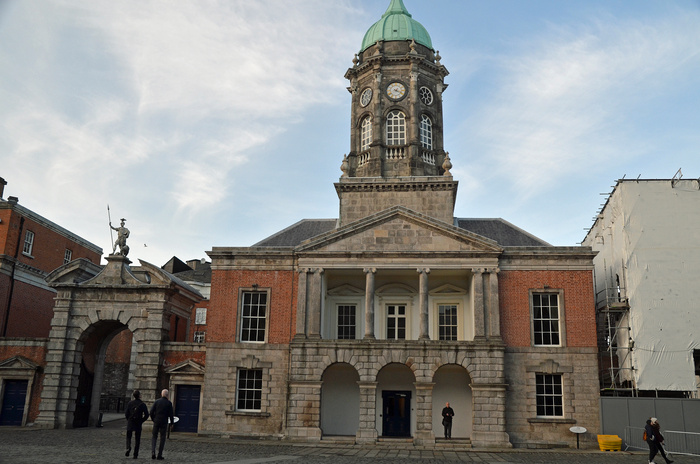
Photo: Dublin Castle, Dublin
Christ Church Cathedral: Christ Church Cathedral is Dublin's oldest building, a leading tourist attraction and a place of pilgrimage for almost 1000 years. Renowned for its beauty, architecture and exquisite floor tiles, it is home to the famous 12th Century crypt, one of the oldest and largest in the UK and the Republic of Ireland. Located in the heart of medieval Dublin, it was founded in 1030 by Sitriuc, King of the Dublin Norsemen, and was incorporated into the Irish Church in 1152.
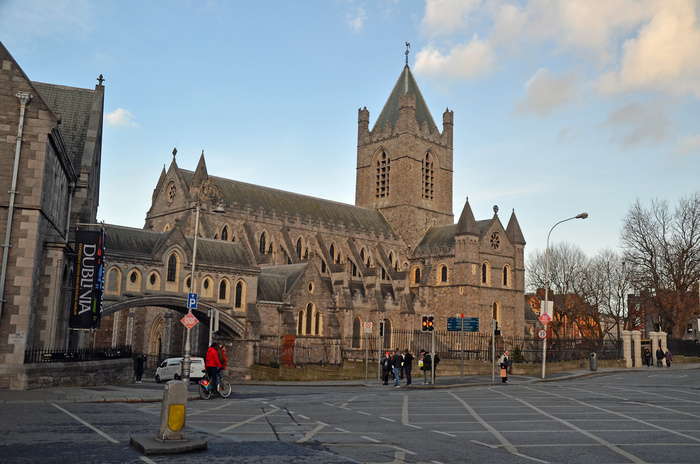
Photo: Christ Church Cathedral, Dublin
And not forgetting the pubs: The Temple Bar, The Cobblestone and The Brazen Head.
Galway:
Galway is a city in County Galway in the west of the Republic of Ireland. It lies on the River Corrib between Lough Corrib and Galway Bay and it is the 6th most populous city in the Republic of Ireland. Galway is renowned for its vibrant lifestyle and for hosting numerous festivals, celebrations and events such as the Galway Arts Festival. The city was designated as the European Capital of Culture for 2020.
Galway was named “one of the world’s top cities for travellers in 2020” by the travel guide Lonely Planet. The city was given the accolade in Lonely Planet’s “Best in Travel 2020”, its annual collection of the best travel destinations, trends, journeys and experiences for the coming year. Lonely Planet describes Galway as “arguably Ireland’s most engaging city” where “brightly painted pubs heave with live music” and “cafes offer front-row seats to watch buskers perform”. Galway features 4th in the list of top cities for 2020.
The following websites provided useful information to assist planning:
This is Galway
Galway Tourism – Galway City
Ireland – Galway
Galway City Pub Guide
The Latin Quarter
I spent most of my time in the Latin Quarter which contains fine examples of the city’s medieval heritage and many of the best known pubs (including the Tig Coili), restaurants and shops centred around High Street, Mainguard Street and adjoining lanes. It proved to be a wonderful area to just walk and take in the atmosphere and street music.
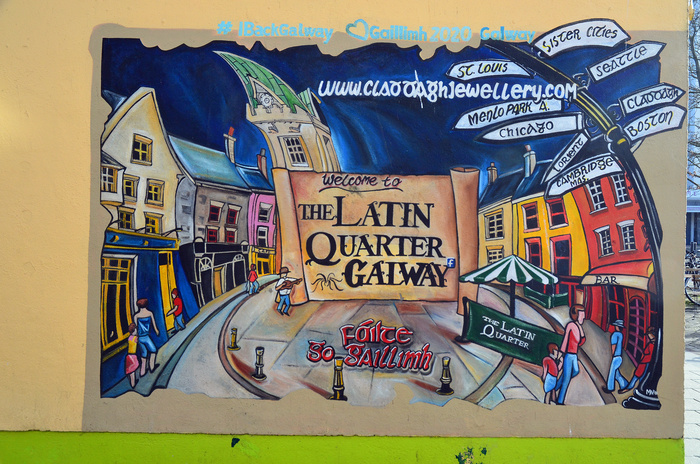
Photo: Latin Quarter, Galway
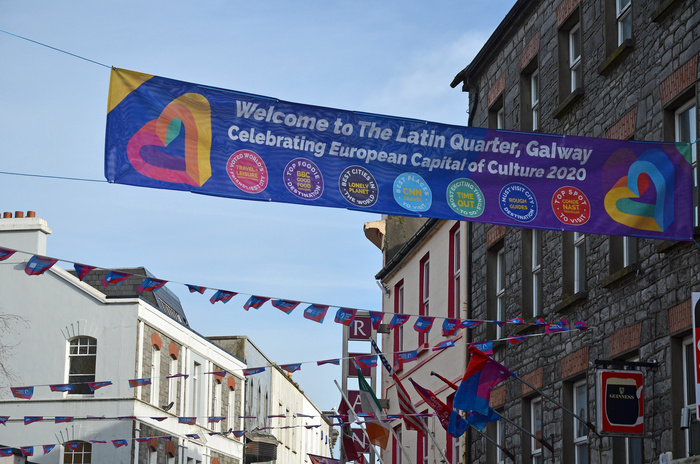
Photo: Latin Quarter, Galway
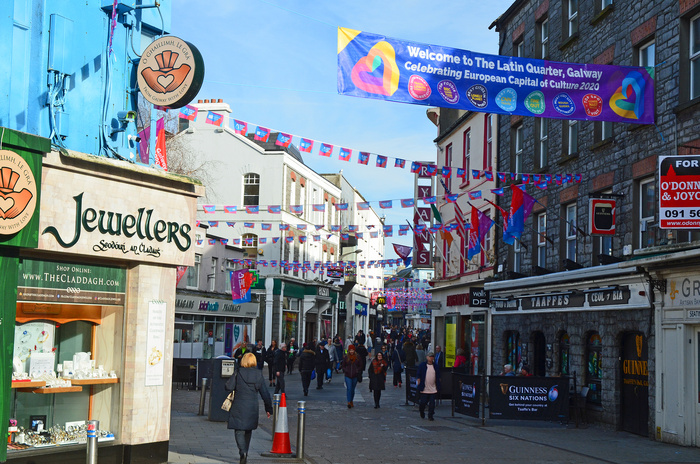
Photo: Latin Quarter, Galway
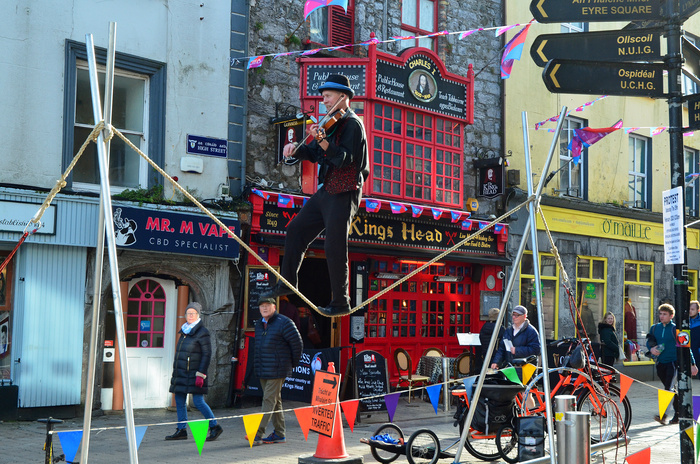
Photo: Latin Quarter, Galway
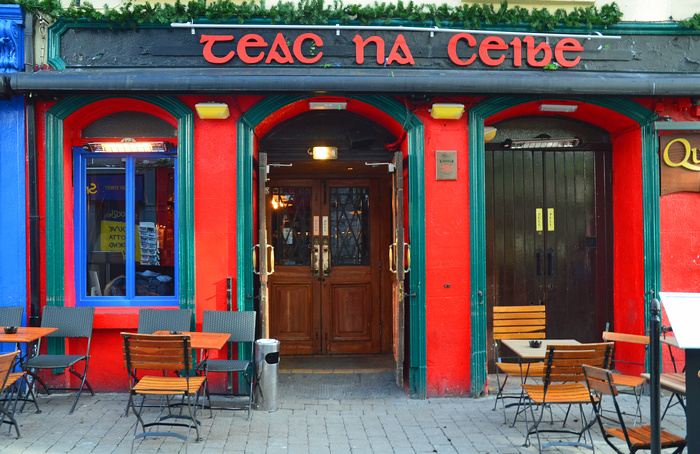
Photo: pub in the Latin Quarter, Galway
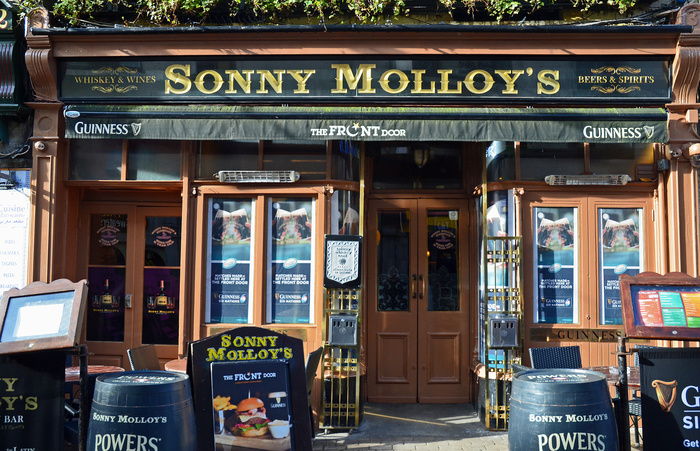
Photo: pub in the Latin Quarter, Galway
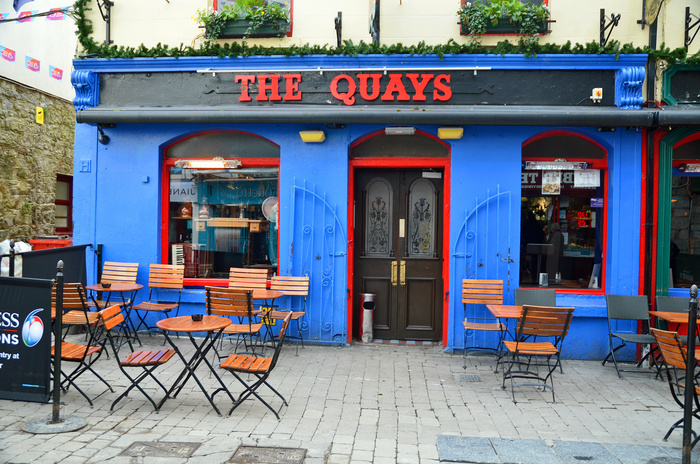
Photo: pub in the Latin Quarter, Galway
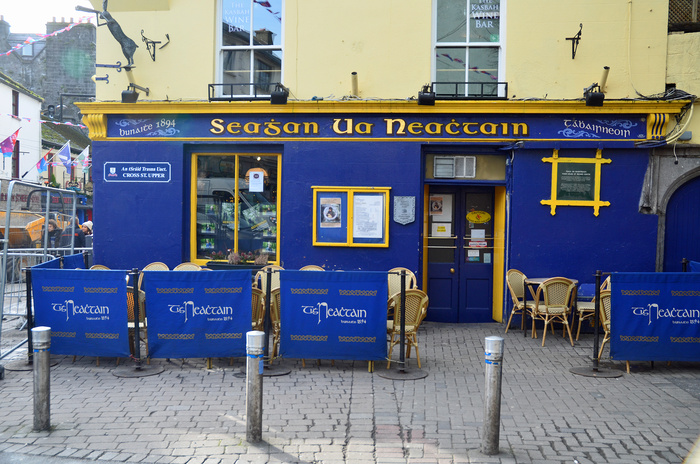
Photo: pub in the Latin Quarter, Galway
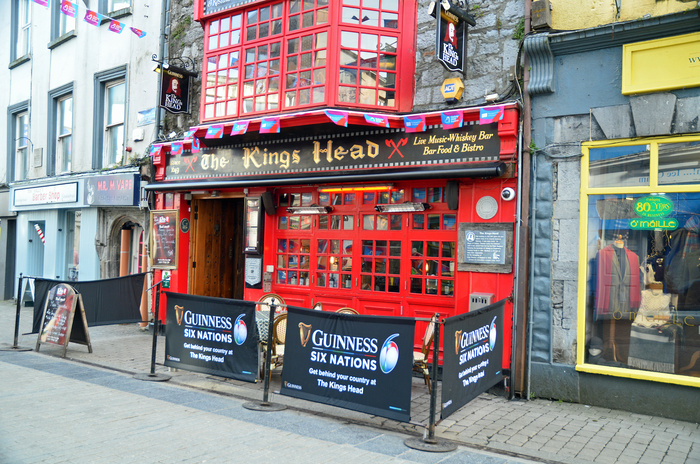
Photo: pub in the Latin Quarter, Galway
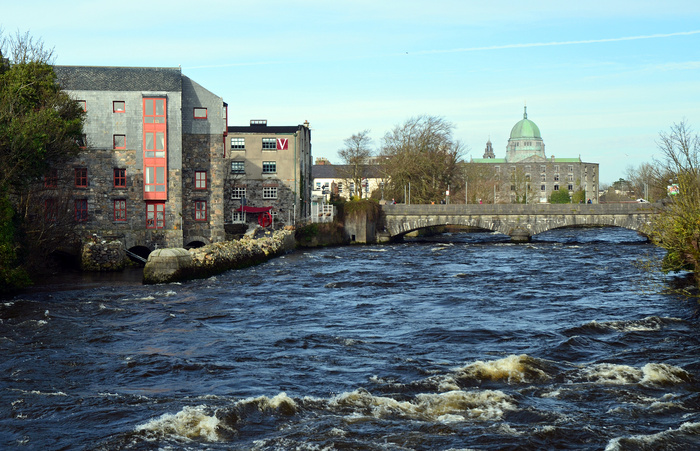
Photo: River Corrib and Cathedral of Our Lady Assumed into Heaven and St Nicholas (Galway Cathedral), Galway
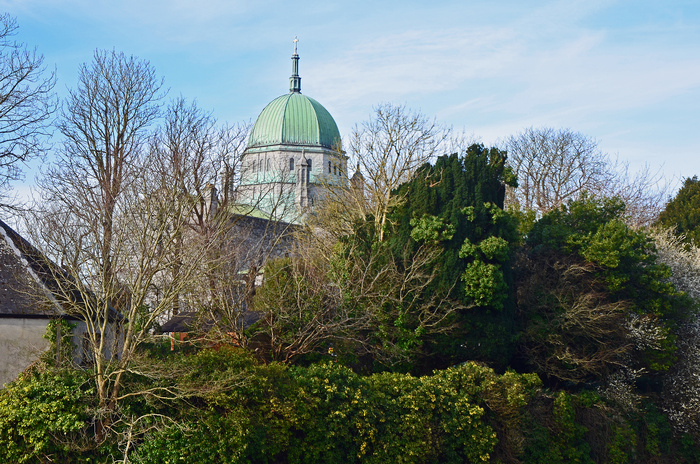
Photo: Cathedral of Our Lady Assumed into Heaven and St Nicholas (Galway Cathedral), Galway
I had also planned to visit the Galway City Museum but unfortunately it was closed for a few days for maintenance and refurbishment.
Referring back to Sharon Shannon, she, Mundy and others contributed to a huge street performance of “Galway Girl” by Steve Earle in Galway in June 2016. This gives some sense of the friendliness and vibrancy of this thoroughly enjoyable city.
Newgrange and Hill of Tara:
The Republic of Ireland contains a very large number of archaeological sites, none more important or more impressive than Newgrange and Hill of Tara in County Meath to the north west of Dublin.
Newgrange is a prehistoric monument in the Brú na Bóinne area of County Meath located about 5 miles west of Drogheda on the north side of the River Boyne. It is an exceptionally grand passage tomb built during the Neolithic period around 3200 BC, making it older than Stonehenge and the Egyptian pyramids.
Newgrange is the most famous monument within the Neolithic Brú na Bóinne area along with the similar passage tomb mounds of Knowth and Dowth and as such it is a part of the Brú na Bóinne UNESCO World Heritage Site.
The site consists of a large circular mound with an inner stone passageway and chambers. Human bones and possible grave goods or votive offerings were found in these chambers. The mound has a retaining wall at the front made mostly of white quartz cobblestones and it is ringed by engraved kerbstones. Many of the larger stones of Newgrange are covered in megalithic art. The mound is also ringed by a stone circle. Some of the material that makes up the monument came from as far away as the Mourne Mountains in County Down in the south east of Northern Ireland and the Wicklow Mountains principally in County Wicklow in the east of Ireland.
There is not complete agreement about what the site was used for but it is believed that it had religious significance. Its entrance is aligned with the rising sun on the winter solstice when sunlight shines through a “roofbox” and floods the inner chamber for a few minutes. In this respect, Newgrange also shares many similarities with other Neolithic constructions in Europe, especially Gavrinis in Brittany in France, Maeshowe in Orkney in Scotland and Bryn Celli Ddu in Wales.
After its initial use, Newgrange was sealed for several millennia. It continued to feature in Irish mythology and folklore in which it is said to be a dwelling of the deities, particularly The Dagda and his son Aengus.
Antiquarians first began studying the site in the 17th century and archaeological excavations took place in the years that followed. Archaeologist Michael J. O'Kelly led the most extensive of these and also reconstructed the frontage of the site in the 1970s.
Newgrange is a popular tourist site and is regarded as one of the most important megalithic structures in Europe. According to the archaeologist Colin Renfrew, it is "unhesitatingly regarded by the prehistorian as the great national monument of Ireland".
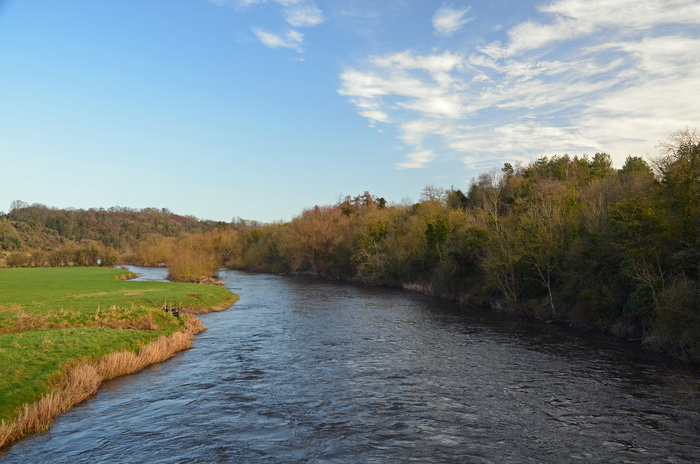
Photo: River Boyne, Brú na Bóinne, County Meath
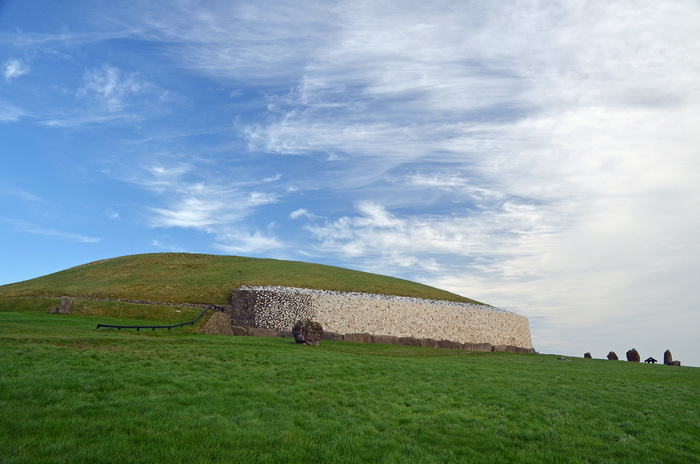
Photo: Newgrange, Brú na Bóinne, County Meath
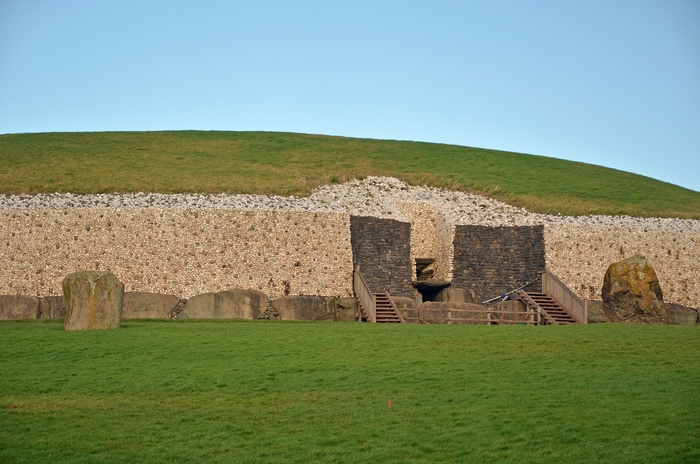
Photo: Newgrange, Brú na Bóinne, County Meath
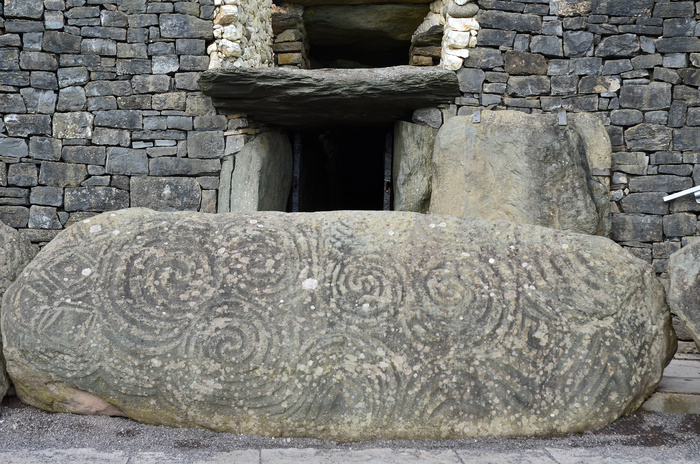
Photo: entrance to Newgrange, Brú na Bóinne, County Meath
Hill of Tara is a hill and ancient ceremonial and burial site 7 miles south of Navan in the Tara-Skryne valley in County Meath. According to tradition, it was the inauguration place and seat of the High Kings of Ireland and it also appears in Irish mythology. Tara consists of numerous monuments and earthworks dating from the Neolithic to the Iron Age. These include a passage tomb (the "Mound of the Hostages"), burial mounds, round enclosures, a standing stone (believed to be the Lia Fáil or the "Stone of Destiny", the coronation stone for the High Kings of Ireland) and a ceremonial avenue.
Saint Patrick's Church is located on the eastern side of the hilltop. The modern church was built between 1822 and 1823 on the site of an earlier one. The earliest evidence of a church at the Hill of Tara is a charter dating from the 1190s. A stump of wall marks the site of the old church today but some of its stonework was re-used in the current church. The building is now the Hill of Tara visitor centre.
The Hill of Tara is part of a larger ancient landscape in the Tara-Skryne valley and the Hill of Tara itself is a protected national monument under the care of The Office of Public Works, an agency of the Irish Government.
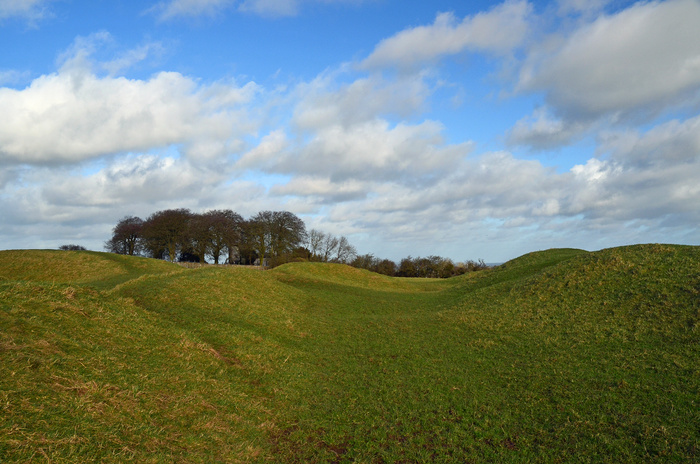
Photo: Hill of Tara, Tara-Skryne valley, County Meath
Cliffs of Moher:
The Cliffs of Moher are located at the south western edge of the Burren region in County Clare and stretch for about 9 miles. At their southern end, they rise 390 feet above the Atlantic Ocean at Hag's Head and 5 miles to the north they reach their maximum height of 702 feet just north of O'Brien's Tower, a round stone tower near the midpoint of the cliffs built in 1835 by Sir Cornelius O'Brien, and then continue at lower heights. The closest villages are Liscannor, 4 miles to the south, and Doolin, 4 miles to the north.
From the Cliffs of Moher, visitors can see the Aran Islands in Galway Bay, the mountain ranges of the Maumturks and Twelve Pins in Connemara in County Galway to the north and Loop Head in County Clare to the south.
The official Cliffs of Moher Coastal Walk runs for about 11 miles from Hag's Head to Doolin. This passes the Visitor Centre and O'Brien's Tower with good viewing throughout subject to rain or sea fog.
There are 2 paths near the Visitor Centre, the official one being set back a little for safety whilst an unofficial path runs closer to the edge. In July 2016 the so-called Cliff Walk, outside the official Cliffs of Moher amenities, was temporarily closed because of the risk of rock falls. People were warned to stay on the official path further away from the cliff edge instead of the unofficial path.
Since 2011, the Cliffs of Moher have formed a part of the Burren and Cliffs of Moher Geopark, one of a family of geotourism destinations throughout Europe that are members of the European Geoparks Network and also recognized by UNESCO. The cliffs are also a "signature point" on the official Wild Atlantic Way tourist trail.
The Cliffs of Moher rank among the most visited tourist sites in Ireland with around 1.5 million visits per year. In the 1990s the local authority, Clare County Council, initiated development plans to enable visitors to experience the cliffs without significant intrusive man-made amenities. In keeping with this approach, a modern visitor centre, the Cliffs of Moher Visitor Experience, was built into a hillside approaching the cliffs. The centre was planned to be environmentally sensitive in its use of renewable energy systems including geothermal heating and cooling, solar panels and grey water recycling. The €32 million facility was planned and built over a 17 year period and officially opened in February 2007. Exhibits include interactive media displays covering the geology, history, flora and fauna of the Cliffs of Moher.
The Cliffs of Moher consist mainly of beds of Namurian shale and sandstone with the oldest rocks being found at the bottom of the cliffs. During the time of their formation between 313 and 326 million years ago, a river dumped sand, silt and clay in to an ancient marine basin. Over millions of years, the sediments collecting at the mouth of this ancient delta were compacted and lithified in to the sedimentary strata preserved in the now exposed cliffs.
Today the Cliffs of Moher are subject to erosion by wave action which undermines the base of support causing the cliffs to collapse under their own weight. This process creates a variety of coastal landforms characteristic of eroded coasts such as sea caves, sea stacks and sea stumps. Branaunmore, a 220 feet high sea stack at the foot below O'Brien's Tower, was once part of the Cliffs of Moher but coastal erosion gradually removed the layers of rock that joined it with the mainland. A large sea arch can also be seen at Hag's Head below the Napoleonic signal tower and many smaller sea arches can be seen from sea level.
During the peak summer breeding season, there are an estimated 30,000 pairs of birds of more than 20 species and the Cliffs of Moher are designated as an Important Bird Area. A wide range of sea life can also be seen from the Cliffs of Moher including Atlantic Grey Seals, various species of whales and dolphins and Basking Sharks.
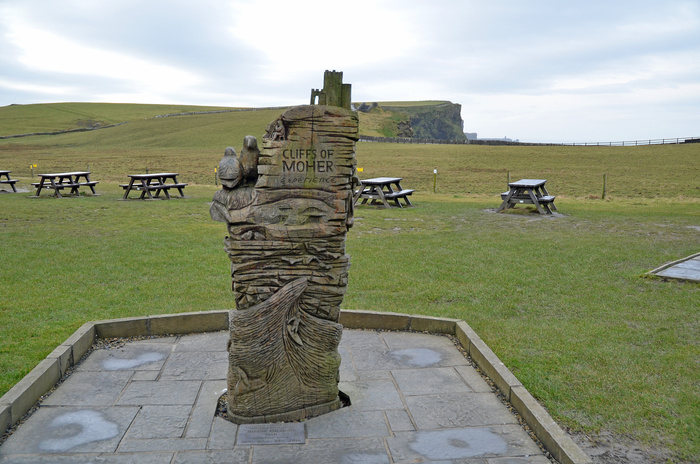
Photo: entrance to the Cliffs of Moher coastal walk, County Clare
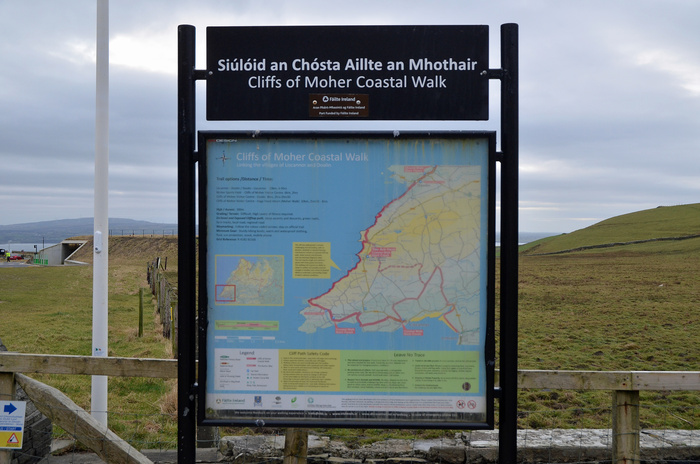
Photo: entrance to the Cliffs of Moher coastal walk, County Clare
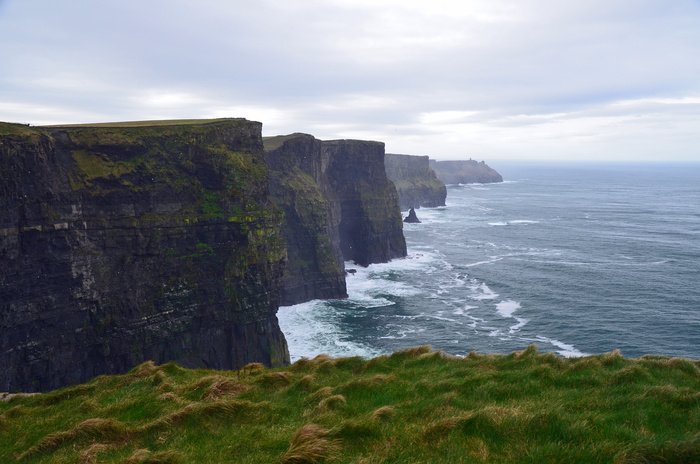
Photo: Cliffs of Moher, County Clare
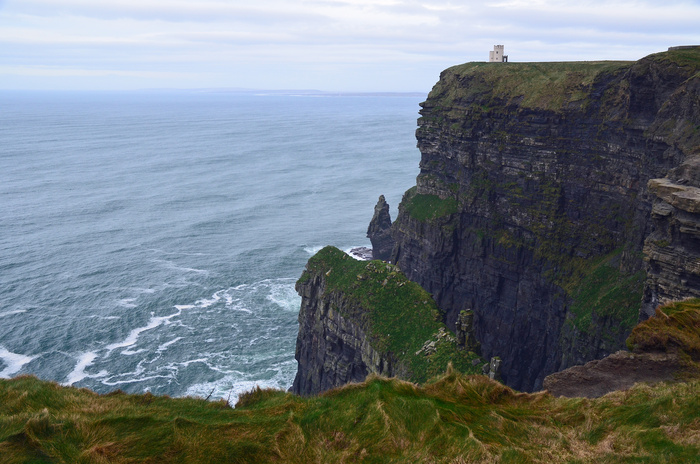
Photo: Cliffs of Moher, County Clare
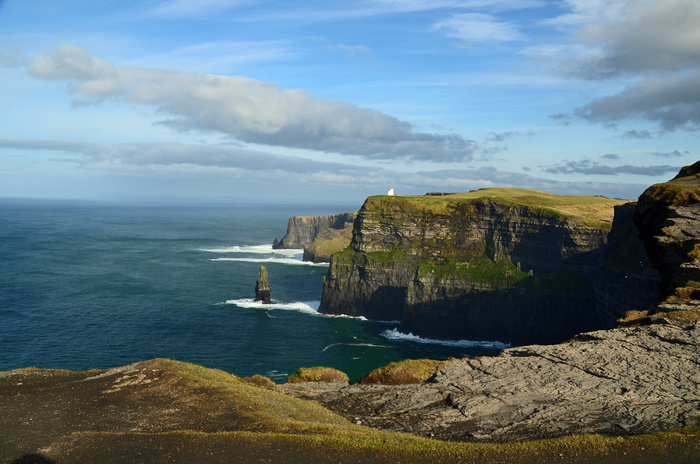
Photo: Cliffs of Moher, County Clare
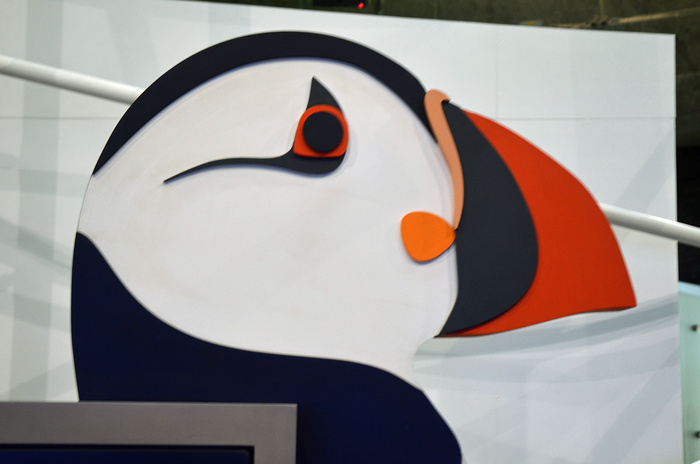
Photo: Puffin at the Cliffs of Moher visitor centre, County Clare
Photos:
During my trip, I took around 220 photos and the best of these can be found in the European trips gallery.
Destination: Republic of Ireland
Purpose of trip:
The purpose of my trip was to visit the Republic of Ireland for winter wildlife watching, together with visits to the archaeological sites of Newgrange and Hill of Tara and to the Cliffs of Moher, a concert in Kilkenny with Sharon Shannon, Mary Coughlan and Frances Black and sightseeing in Galway and Dublin.
It was inspired by 3 main factors:
Firstly, having visited all of the countries in western Europe, other than Portugal, Liechtenstein and the Republic of Ireland, and several other countries in eastern Europe, I thought it was about time that a close neighbour to the UK just across the Irish Sea deserved my attention.
Secondly, and related to the above, my Mum, who sadly died in September 2018, frequently asked me after my annual visits to Scotland and my trips to Europe …. “Have you ever thought about going to Ireland?”. Mind you, I think that was more about her being a big fan of Daniel O’Donnell who she insisted represented traditional Irish music (I think not!).
Thirdly, I needed a self-designated "Bollocks to Brexit" trip in a bid to escape a nation in which a far too vocal minority were exhibiting narrow-minded and economically illiterate English nationalism at best and bigotry and racism and worst. I wanted to avoid all coverage of the inevitable Brexit triumphalism and celebrations of that minority on 31st January 2020. I deduced that the famed Irish hospitality, Guinness and traditional music would live up to expectation (it did) and that it would provide a perfect distraction and antidote (it did). Furthermore, the timing of my trip would ensure that I would be away on 1st February 2020 for Imbolc, a Gaelic traditional festival marking the beginning of spring and something far more meaningful and worthy of celebration than Brexit.


Photo: County Clare, Republic of Ireland and EU flags at the Cliffs of Moher
Republic of Ireland – background:


Ireland (Irish: Éire) is an island situated in the north Atlantic Ocean. It is separated from the UK to its east by the North Channel, the Irish Sea, the Celtic Sea and St George's Channel. It is the second largest island of the British Isles, the third largest in Europe and the 20th largest in the world. Geopolitically, Ireland is divided between the Republic of Ireland (officially named Ireland), which covers about 83% of the island and Northern Ireland which is part of the UK.
The geography of Ireland comprises relatively low-lying mountains surrounding a central plain with several navigable rivers extending inland. Its lush vegetation is a product of its mild but changeable climate which is free of extremes in temperature. Much of Ireland was woodland until the end of the Middle Ages. Today, woodland makes up about 10% of the island compared with a European average of over 33% and most of it is non-native conifer plantations.
The Irish climate is influenced by the Atlantic Ocean and thus very moderate. Winters are milder than expected for such a northerly area although summers are cooler than those in continental Europe. Rainfall and cloud cover are abundant.
The earliest evidence of human presence in Ireland is dated at 10,500 BC. Gaelic Ireland had emerged by the 1st century AD. The island was Christianised from the 5th century onward. Following the 12th century Norman invasion, England claimed sovereignty. However, English rule did not extend over the whole island until the 16th and 17th centuries Tudor conquest which led to colonisation by settlers from Britain. In the 1690s, a system of Protestant English rule was designed to materially disadvantage the Catholic majority and Protestant dissenters and was extended during the 18th century. With the Acts of Union in 1801, Ireland became a part of the UK. A war of independence in the early 20th century was followed by the partition of the island, creating the Irish Free State, which became increasingly sovereign over the following decades, and Northern Ireland, which remained a part of the UK.
The Republic of Ireland occupies 26 of the 32 counties of the island of Ireland. The capital and largest city is Dublin which is located on the eastern side of the island. Around a third of the country's population of 4.9 million people resides in the greater Dublin area. The Republic of Ireland shares its only land border with Northern Ireland and it is otherwise surrounded by the Atlantic Ocean to the west, the Celtic Sea to the south, St George's Channel to the south east and the Irish Sea to the east.
The Republic of Ireland is a unitary parliamentary republic. The legislature, the Oireachtas, consists of a lower house (Dáil Éireann), an upper house (Seanad Éireann) and an elected President (Uachtarán) who serves as the largely ceremonial head of state but with some important powers and duties. The head of government is the Taoiseach (Prime Minister, literally “Chief”, a title not used in English) who is elected by the Dáil and appointed by the President. The Taoiseach in turn appoints other government ministers.
The Republic of Ireland was created as the Irish Free State in 1922 as a result of the Anglo-Irish Treaty. It had the status of a Dominion, a semi-independent state within the British Empire, until 1937 when a new constitution was adopted in which the state was named "Ireland" and effectively became a republic with an elected non-executive president as head of state. It was officially declared a republic in 1949 following the Republic of Ireland Act 1948. The Republic of Ireland became a member of the United Nations in December 1955 and it joined the European Economic Community (EEC), the predecessor of the European Union (EU), in 1973.
The Republic of Ireland had no formal relations with Northern Ireland for most of the 20th century but during the 1980s and 1990s the British and Irish governments worked with the Northern Ireland parties towards a resolution to "The Troubles". Since the signing of the Good Friday Agreement in 1998, the Irish government and the Northern Ireland Executive have co-operated on a number of policy areas under the North-South Ministerial Council created by the Agreement.
The Republic of Ireland ranks among the top 10 wealthiest countries in the world in terms of GDP per capita and as the 10th most prosperous country in the world according to The Legatum Prosperity Index 2015.
After joining the EEC, the Republic of Ireland enacted a series of liberal economic policies that resulted in rapid economic growth. The country achieved considerable prosperity between the years of 1995 and 2007 which became known as the “Celtic Tiger” period. This was halted by an unprecedented financial crisis that began in 2008 in conjunction with the concurrent global economic crash. However, as the economy was one of the fastest growing in the EU in 2015, the Republic of Ireland again quickly ascended league tables comparing wealth and prosperity internationally.
In 2019, the Republic of Ireland was ranked the 3rd most developed country in the world by the United Nations Human Development Index which is a composite index of life expectancy, education and per capita income indicators. It also performs well in several national performance metrics including freedom of the press, economic freedom and civil liberties.
The Republic of Ireland is a member of the European Union and it is a founding member of the Council of Europe and the OECD. The Irish government has followed a policy of military neutrality through non-alignment since immediately prior to World War 2 and therefore the Republic of Ireland is consequently not a member of NATO although it is a member of Partnership for Peace (a NATO programme aimed at creating trust between NATO and other states in Europe and the former Soviet Union).
Primary target areas:

I undertook a route around the east and south coast of the Republic of Ireland from Dublin, my arrival point in the country.
The primary target areas for wildlife watching during my trip were:
County Wicklow

County Wicklow (Irish: Contae Chill Mhantáin) is part of the Mid East Region and also part of the traditional province of Leinster. It is the 17th largest of the Republic of Ireland's 32 counties by area and the 16th largest by population. The adjoining counties are County Wexford to the south, County Carlow to the south west, County Kildare to the west and County Dublin to the north.
County Wicklow is named after the town of Wicklow which derives from the Old Norse name Víkingaló meaning "Vikings' Meadow".
The Wicklow Mountains form the largest continuous upland region in the Republic of Ireland. The highest peak is Lugnaquilla at 3035 feet.
County Wicklow, colloquially known as "the Garden of Ireland", has been a popular tourist destination for many years due to its scenery, beaches, walking, hiking and climbing options and various attractions including the ruins of the monastic city of Glendalough, Wicklow Gaol and water-based activities on reservoirs and the coast.
The Wicklow Way is the oldest waymarked long-distance walking trail in the Republic of Ireland.
In County Wicklow, I principally focused on the following sites:
Kilcoole
East Coast Nature Reserve
Avoca.
County Wexford

County Wexford (Irish: Contae Loch Garman) is part of the South East Region and also part of the traditional province of Leinster. It is the 13th largest of the Republic of Ireland's 32 counties by area and the 14th largest by population. It is located in the south east corner of the Republic of Ireland and bounded by the sea on 2 sides, to the south by the Atlantic Ocean and to the east by St. George's Channel and the Irish Sea. The River Barrow forms its western boundary. The Blackstairs Mountains form part of the boundary to the north as do the southern edges of the Wicklow Mountains. The adjoining counties are County Waterford to the south west, County Kilkenny to the west, County Carlow to the north west and County Wicklow to the north.
County Wexford is named after the town of Wexford and was based on the historic Gaelic territory of the dynasty of Hy Kinsella (Uí Ceinnsealaigh) whose capital was Ferns.
County Wexford is known as Ireland's "sunny south east" because, in general, the number of hours of sunshine received daily is higher than in the rest of the Republic of Ireland. This has resulted in County Wexford becoming one of the most popular places in the Republic of Ireland in which to live. It has a mild but changeable oceanic climate with few extremes.
In County Wexford, I principally focused on the following sites:
Wexford Harbour and Slobs including Wexford Wildfowl Reserve
Cahore Marsh
Curracloe Strand
Rosslare Bank Strand
Rosslare Harbour
Lady’s Island Lake
Tacumshin Lake
Kilmore Quay
Bannow Bay
Hook Head
County Waterford

County Waterford (Irish: Contae Phort Láirge) is part of the South East Region and also part of the traditional province of Munster. It is the 20th largest of the Republic of Ireland's 32 counties by area and the 20th largest by population. County Waterford has 2 mountain ranges: the Knockmealdown Mountains and the Comeragh Mountains. The highest peak is Knockmealdown at 2605 feet. The adjoining counties are County Cork to the west, County Tipperary to the north west, County Kilkenny to the north east and County Wexford to the east.
County Waterford is named after the city of Waterford.
There are over 30 beaches along County Waterford's volcanic coastline and a large stretch of this, known as the “Copper Coast”, was designated as a European Geopark in 2001 and as a UNESCO Global Geopark in 2004 due to its geological importance.
In County Waterford, I principally focused on the following sites:
Waterford Harbour
Tramore Bay and Tramore Back Strand
Clonea
Dungarvan Bay
Helvick Head
County Cork

County Cork (Irish: Contae Chorcaí) is part of the South West Region and also part of the traditional province of Munster. It is the largest of the Republic of Ireland's 32 counties by area and the 3rd largest by population. The adjoining counties are County Kerry to the west, County Limerick to the north, County Tipperary to the north east and County Waterford to the east.
County Cork is named after the city of Cork, the Republic of Ireland's 2nd largest city.
In County Cork, I principally focused on the following sites (all in the extreme east):
Youghal Bay
Ballymacoda Bay
Ballycotton Bay
On my return to Dublin, I drove through County Kilkenny, County Carlow, County Kildare and County Meath (for the archaeological sites of Newgrange and Hill of Tara) but I did not stop at any specific sites for birding. In County Dublin, I did visit the Swords-Malahide estuary approximately 45 miles north of Dublin.
On my train trip from Dublin west to Galway, I travelled through County Laois, County Offaly, County Westmeath and County Galway. Only a few common species were seen from the train.
From Galway, I travelled by coach to the Cliffs of Moher. This beautiful route around Galway Bay, the coastline of County Galway and County Clare and through the The Burren did produce some notable window-spotted coastal species such as Red-throated Diver, Gannet, Wigeon, Curlew and Oystercatcher plus Redwing, Stonechat and Hooded Crow. At the Cliffs of Moher SPA, the cliff edges were already populated by Fulmars, Guillemots, Razorbills and Herring Gulls despite it still being only early February. Ravens were also evident.
Getting there:
Having taken 5 flights during 2019 plus several flights in previous years, I have made a conscious decision to not fly to or from European destinations in the future due to the adverse impact of flights on carbon emissions and the climate emergency. I will be writing more about this on my website.
I have supported “Flight Free 2020”. The Flight Free 2020 pledge is an international campaign encouraging people to fly less. It is currently active in the UK, Sweden, the Netherlands, Germany, Canada, the USA and Australia. Flight Free UK is part of the Stay Grounded Network which is running the Europe-wide "Let's Stay Grounded" campaign in 2020 and 2021.

There is no reason at all to fly to the Republic of Ireland and travelling by train and ferry is both enjoyable and cheap. Furthermore, it is estimated that travelling this way reduces CO2 emissions by around 70% to 75% compared with flying.
A cheap single “Rail and Sail” ticket between any rail station in the UK and any rail station in the Republic of Ireland includes both train and ferry travel. More information on “Rail and Sail” travel to/from the Republic of Ireland can be found at Mark Smith’s website, The Man in Seat 61 or at Irish Ferries.

Map: "Rail and Sail" routes to/from the Republic of Ireland
For my return trip to Dublin, I used the rail service provided by Avanti West Coast and the ferry service provided by Irish Ferries.
The outward journey from my home town of Basildon to Dublin cost £50. Ignoring the Basildon to London leg, the schedule was as follows: depart London Euston 09:10 and arrive Holyhead Port 12:52, depart Holyhead Port 14:10 and arrive Dublin Ferryport 17:25
The return journey from Dublin to Basildon cost £44.50. Again, ignoring the London to Basildon leg, the schedule was as follows: depart Dublin Ferryport 08:05 and arrive Holyhead Port 11:20, depart Holyhead Port 12:53 and arrive London Euston 16:36
The train journey was particularly enjoyable between Chester and Bangor where it followed the north Wales coastline offering a different perspective of many locations that I have driven through or visited on previous trips to Wales, most notably Conwy and its well-preserved 13th century castle, Conwy RSPB reserve, the Snowdonia mountains and the Menai Strait.
The ferry journey provided an excellent view of the cliffs of South Stack RSPB reserve on Anglesey, a site that I have visited on an annual basis for many years, and a lovely winter evening sky over the Wicklow Mountains on the approach to Dublin Ferryport.
On both the outward and return ferry journey, there was a warning regarding moderate to rough seas but on both crossings there was only a very slight roll even though the Irish Sea did indeed look rather rough outside.
The W.B. Yeats ferry, named after the well-known Irish poet W.B. Yeats, is a large and modern ferry and proved to be an extremely relaxing way to cross the Irish Sea to Dublin.

Photo: W.B. Yeats
Getting around:
On arrival at Dublin Ferryport, I took the bus provided by Morton’s Coaches to Dublin city centre and then the bus provided by Airlink Express to Dublin Airport. For my return journey, I took a taxi from my last night’s accommodation at Amberley House in Dublin city centre to Dublin Ferryport.
At Dublin Airport, I rented a Peugeot 208 for 7 days via Thrifty booked in advance. The cost of car rental was a mere 34.80 euros (£31.05), an amazingly low price which made me check the quote at least twice before booking! The only additional cost was 4 x 3.10 euros (£10.52) in respect of the expected M50 motorway tolls around Dublin which were recharged back to me after I returned the car.
The car proved to be reliable and economical. The cost of petrol in Ireland was broadly similar to the UK with Applegreen proving to be the cheapest.
During my trip around Ireland, I drove 870 km (540 miles). In and around Dublin, the roads were exceptionally busy and congested especially at peak times and including the C-shaped M50 orbital motorway around the city. However, outside Dublin and its immediate surrounding areas and in the mostly rural areas which I visited during the majority of my trip, the roads were generally quiet.
On 5th February 2020, I travelled by train from Dublin Heuston to Galway Ceantt. I returned on 6th February 2020. The railway stations are named after Seán Heuston and Éamonn Ceannt, both of whom were Irish republicans who took part in the Easter Rising in April 1916 and were subsequently executed by firing squad in Kilmainham Gaol in Dublin. I booked 2 single tickets for my return journey in advance via Irish Rail. The total booking cost was 35.98 euros (£30.70) but see below regarding enforced changes and additional costs to my return journey. The outward schedule was as follows: depart Dublin Heuston 7:35 a.m. and arrive Galway Ceantt 10:08 a.m. The return schedule was as follows: depart Galway Ceantt 5:20 p.m. and arrive Dublin Heuston 7:54 p.m. More information on train travel in the Republic of Ireland can be found at Mark Smith’s website, The Man in Seat 61.

Map: Irish railway network
On 6th February 2020, I travelled by coach from Galway to the Cliffs of Moher. I booked a return journey in advance on service 350 via Bus Éireann.
The total booking cost was 25 euros (£21.23). The outward schedule was as follows: depart Galway bus station 8:00 a.m. and arrive Cliffs of Moher coach park 10:15 a.m. My planned return schedule was as follows: depart Cliffs of Moher coach park 11:20 a.m. and arrive Galway bus station 1:30 p.m. The return schedule would have enabled me to spend some more time in Galway before catching my return train to Dublin at 3:05 p.m. and using my non-flexible train ticket. However, despite going back to the Cliffs of Moher coach park in time for the arrival of the return coach at 11:20 a.m., the coach failed to stop despite me gesturing. As such, my return schedule was put back as follows: depart Cliffs of Moher coach park 1:20 p.m. and arrive Galway bus station 3:30 p.m. This resulted in me missing the 3.05 p.m. train to Dublin and I incurred an additional cost of 19.99 euros (£16.98) by having to buy another train ticket since my original return ticket was invalid.
As it turned out, the 2 hours additional time spent at the Cliffs of Moher allowed for further walks at this spectacular site plus the earlier cloudy/misty weather cleared to bright sunshine. Nonetheless, I submitted a complaint to Bus Éireann regarding my return journey together with additional issues in respect of their service i.e. the cold temperature on the coach, the smell on the bus, the absence of any wi-fi despite a notice saying it was available and the grumpy and uncommunicative driver. Eventually, after escalating my complaint, I received a full refund of my coach ticket which more than covered the cost of the additional train ticket. Given that I had been able to spend longer at the Cliffs of Moher than originally planned, this was a satisfactory outcome all round!
In Dublin, I travelled around the city largely by foot but I also used public transport. Dublin Bus and Luas provide excellent bus and tram services respectively. The easiest and most cost effective way of using public transport in Dublin is to buy a Leap Visitor Card.
Itinerary:
I travelled independently following thorough research and preparing an itinerary before leaving the UK.
28th January 2020: Basildon > London Euston > Holyhead Port > Dublin Ferryport > Dublin > Dublin Airport > pick up rental car > Dublin
29th January 2020: Dublin > Bray > Kilcoole > East Coast Nature Reserve > Avoca > Cahore Marsh > Wexford > Rosslare Strand
30th January 2020: Rosslare Strand > Rosslare Back Strand > Lady’s Island Lake > Wexford > Wexford Wildfowl Reserve > Curracloe Strand (Ballinesker) > Wexford > Rosslare Strand
31st January 2020: Rosslare Strand > Tacumshin > Kilmore Quay > Bannow Bay (Carrick, Wellingtonbridge and Tintern Bridge) > Hook Peninsula and Hook Head > Duncannon
1st February 2020: Duncannon > Ballyhack > Passage East Ferry > Passage East > Dunmore East > Tramore Bay and Tramore Back Strand (Saleen and Tramore) > Annestown > Boatstrand > Kilmurrin Cove > Dungarvan Bay (Barnawee Bridge and Ballynacourty Pier and Ballynacourty Point, Ballinclamper, Dungarvan and Helvick Head) > Helvick > Stradbally
2nd February 2020: Stradbally > Dungarvan Bay (Barnawee Bridge and Cunnigar) > Youghal Bay > Pilmore Strand > Ballycotton > Ballymacoda > Dungarvan Bay (Dungarvan) > Waterford > Kilkenny
3rd February 2020: Kilkenny > Newgrange > Hill of Tara > Swords > Malahide > Portmarnock > Dublin Airport > return rental car > Dublin
4th February 2020: Dublin
5th February 2020: Dublin Heuston > Galway Ceantt > Galway
6th February 2020: Galway > Cliffs of Moher > Galway > Galway Ceantt > Dublin Heuston > Dublin
7th February 2020: Dublin > Dublin Ferryport > Holyhead Port > London Euston > Basildon
Accommodation:
Prior to my trip, I had pre-booked the following accommodation either directly or via ebookers.com or booking.com.
28th January 2020: Dublin – No. 9 Rathgar by the Key Collections – 44 euros (£37.76) for 1 night

No. 9 Rathgar by the Key Collections is a beautiful 3 storey Georgian house located in the architectural conservation zone of Rathgar, a quiet residential suburb about 2 miles south east of Dublin city centre. One of the most famous residents of Rathgar was James Joyce, the Irish novelist, short story writer, poet, teacher and literary critic. Travel to and from the city centre is very easy using the frequent and regular buses which stop nearby. There is very limited on-site parking (although I found a space easily) but there is plenty of free on-street parking.
I received a very warm welcome from Carolina on reception and played “guess the nationality” which I lost after several incorrect guesses. Carolina is from Brazil but speaks perfect English.
Although a Georgian house, my room had been renovated and modernised and was spotlessly clean and decorated in shades of grey and white. The room contained a large and comfortable double bed, an en-suite shower and WC, a kettle and supply of tea, coffee and biscuits, a small fridge, a small safe, a TV and a desk and stool. There was a strong wi-fi reception in the room and throughout the accommodation.
No. 9 Rathgar by the Key Collections offers accommodation on a room only basis i.e. there is no breakfast or other meals. However, Carolina provided a map showing the location of restaurants, cafes and supermarkets within close walking distance. I had my evening meal at Lumanti of Nepal, a 10 minute walk from No. 9 Rathgar by the Key Collections. Lumanti had a nice atmosphere and friendly service and provided excellent Nepalese food at a cost of 29.90 euros (£26.34) although I was offered a free beer since they had forgotten to add my second to the bill.
No. 9 Rathgar by the Key Collections is highly recommended as value for money accommodation away from the noise of the city centre but with good neighbourhood services and transport links.
29th and 30th January 2020: Rosslare Strand, County Wexford – Coast Rosslare Strand – £86.43 for 2 nights

Coast Rosslare Strand is a large and modern hotel located in the coastal village of Rosslare Strand in County Wexford. The reception was friendly and the check-in was very quick.
The large room had a distinct marine feel with its dried grasses, shells and sea-themed paintings and contained a double bed, an en-suite bath and WC, a kettle and supply of tea and coffee, a TV and a desk and chair and a small table and chairs. There was a strong wi-fi reception in the room and throughout the accommodation. Although the main room was clean and comfortable enough, the bathroom had numerous patch repairs and decorations and was in desperate need of modernisation. In addition, the lighting in the main room was totally insufficient. There was no central ceiling light and lighting was therefore limited to a light over the desk and very poor bedside lighting. There were also very few power sockets and none at all by the bed other than one behind and below the bed itself.
The bar provided friendly service, excellent Guinness and a limited but very good menu including a daily special for a starter, main course and dessert. Evening meals (including a few pints of Guinness!) cost 36.90 euros (£31.27) and 39 euros (£33.09). On 29th January, I was also able to watch the Manchester derby in the second leg of the League Cup on the big screen in the bar.
I would stay at Coast Rosslare Strand again if visiting the area but hopefully they will improve the room in respect of the issues that I have mentioned.
31st January 2020: Duncannon, County Wexford – Seashells B&B – £39.61 for 1 night

Seashells B&B is located in the small village of Duncannon in County Wexford and easily won the “view from the accommodation” award during my trip with its views of the long sandy beach, Waterford Harbour, the Hook peninsula and Hook Head.
It is a small 3 room bed and breakfast accommodation run by the very friendly Eric and Dympna. There is no on-site parking but the accommodation is situated in a quiet residential street with plenty of free on-street parking. The small room was spotlessly clean and contained a double bed, a small en-suite shower and WC plus an amazing view with the sound of the sea with the window open. The immediately adjacent communal lounge area (with the same view) contained a sofa, chairs, breakfast table, TV and a supply of tea, green tea, coffee, hot chocolate and biscuits. I was the only guest during my stay and therefore had the communal area to myself although I suspect that it could become a bit crowded if all rooms were occupied. There was a strong wi-fi reception in the room, in the communal area and throughout the accommodation. Breakfast was included in the nightly rate and was excellent.
No evening meals are provided and options in the village are basically limited to Roches Bar and Strand Tavern. I had an evening meal at the former, one of the oldest traditional bars in the area. The pub style food plus obligatory Guinness cost 29.85 euros (£25.18).
Seashells B&B is highly recommended when visiting the Hook peninsula and south west County Wexford and for onward travel via the Passage East ferry across Waterford Harbour in to County Waterford.
1st February 2020: Ballyvoile near Stradbally, County Waterford – Comergah View B&B – 50 euros (£43.62 including currency exchange fees) for 1 night

Comeragh View B&B is located in the small settlement of Ballyvoile near the village of Stradbally and 8 miles east of the coastal town of Dungarvan in County Waterford. Named after the Comeragh Mountains, it easily won the “accommodation hospitality” award during my trip.
It is a small bed and breakfast accommodation run by the exceptionally welcoming and friendly Maureen and Tony for 41 years! Whilst clearly sign-posted at 2 points off the R675 Tramore to Dungarvan road, it can be very difficult to find when it is dark. I found it easily enough when I arrived in daylight but it was somewhat more challenging when I returned after my evening meal in Dungarvan. When I arrived, Maureen provided tea, home-made cake, recommendations for evening meals in Dungarvan and a very interesting discussion on Brexit, the future of the UK monarchy and the election in the Republic of Ireland. The small room was very clean but a bit dated and the pink and violet décor would not be everyone’s choice (including mine). It contained a double bed, a small en-suite shower and WC, a small TV and a supply of tea, coffee, bottled water, biscuits, sweets and chocolates. Plenty of on-site parking was available. Breakfast, prepared by Tony, was included in the nightly rate and was superb.
The nearby town of Dungarvan provides a wide range of different options to eat but it was extremely busy on a Saturday night. I had my evening meal at Crew’s, a restaurant situated in a restored 16th century building previously used as a work house, a grain store and leather factory. The very young service staff were exceptional and the seafood meal costing 32.80 euros (£27.67) was excellent.
There are many accommodation options in the town of Dungarvan but Comeragh View B&B is highly recommended as a rural and therefore very quiet choice.
2nd February 2020: Kilkenny, County Kilkenny – Hotel Kilkenny – £70.24 for 1 night

Hotel Kilkenny is located on the edge of the town of Kilkenny. I chose Kilkenny and this particular hotel since I wanted a stop-over roughly half way between County Cork and Dublin and an out-of-town hotel due to the many reviews of town centre hotels commenting on the noise.
Hotel Kilkenny is a 4 star large hotel and it was by far the most expensive accommodation during my trip. It was also the most disappointing by a long way. The basic room only rate with no breakfast offered very poor value for money even after allowing for my ebookers.com member’s discount and cashback. I have stayed in numerous refurbished Travelodges for half or even a third of the price and enjoyed a substantially better experience. The hotel exterior and large reception area probably does suggest a 4 star rating but the rooms, or at least the one that I stayed in, certainly did not. The large room contained a double bed with an en-suite bath and shower but the whole room required improvement and modernisation in terms of décor, furniture, fixtures and fittings. The room was also hot with no temperature control or air conditioning.
In addition, the restaurant appeared to be closed and the bar was extremely crowded due to the evening concert with Sharon Shannon, Mary Coughlan and Frances Black. Having finally found somewhere to sit, I had an evening meal. The service, despite it being so busy, was very good but the menu was very limited and not particularly interesting.
The highlight of my stay at Hotel Kilkenny was nothing to do with the accommodation but the brilliant concert (see more on this below).
Given the issues that I have detailed, I would not recommend Hotel Kilkenny and I would look at other accommodation options in or around Kilkenny if I visited again.
3rd and 4th February 2020: Dublin – No. 9 Rathgar by the Key Collections – 96.80 euros (£83.02) for 2 nights
Having stayed at No. 9 Rathgar by the Key Collections on the first night of my trip, I returned for a 2 night stay after returning my rental car (see above for my comments on this excellent accommodation).
Given that no meals are provided by the accommodation, I had my 2 evening meals at The Brazen Head in Dublin city centre and The Bijou in Rathgar. The Brazen Head is reputed to be the oldest pub in the Republic of Ireland. It was built as a coaching inn in 1754 on the site of a merchant's dwelling dating back to at least 1613. Local tradition claims that the site has housed a tavern or alehouse since 1198. Needless to say, it had loads of atmosphere and the huge portion of traditional Irish stew and obligatory 2 pints of Guinness at a cost of 22.30 euros (£19.04) was thoroughly enjoyable and good value for money. The Bijou is a bistro style restaurant and the excellent meal here from the “ daily set menu” with a glass of wine cost 27.55 euros (£23.52). My seat by the window also provided me with one of my trip records of Red Fox!
5th February 2020: Galway – The Nest – 61.20 euros (£54.11 including currency exchange fees) for 1 night

The Nest is located in the Salthill neighbourhood of Galway although easily connected to the city centre by the frequent and regular buses which stop nearby. It is described as a “boutique hostel” (what ever that is!) and includes both hostel type shared dormitory accommodation plus self-contained rooms. I received a very warm welcome from Mark on reception who dealt with check-in and explained the communal facilities.
The small room was rather basic and spartan. It contained a double bed, a small en-suite shower and WC and a small desk and chair. There was no TV or kettle and tea and coffee in the room although drinks were available in the communal area of the main building. Although the accommodation was clean, comfortable and quiet, I am not convinced that it was worthy of the nightly rate charged for it.
No evening meals are provided at The Nest but Galway offers numerous eating and drinking opportunities. I initially enjoyed a few pints of Guinness and some brilliant traditional Irish music at Tig Coili. Afterwards, I had my evening meal at The Piemaker, a tiny restaurant offering a range of home-made pies (there is a clue in the name!). The excellent meal including a glass of wine cost just 18.50 euros (£15.71).
Although I had no major issues with The Nest, I think I would probably look at other accommodation options in Galway if I visited again.
6th February 2020: Dublin – Amberley House by the Key Collections – 40.50 euros (£34.73) for 1 night

Amberley House by the Key Collections is a 3 storey Georgian house located on Lower Gardiner Street just north of Dublin city centre. I chose Amberley House by the Key Collections for the last night of my trip (rather than a further night’s stay at No. 9 Rathgar by the Key Collections) due to its much closer proximity to Dublin Ferryport for my return journey home.
However, it is situated on a main street with inevitable noise although fortunately my room was on the top floor so this was not particularly a problem. Having said that, a top floor room presented another problem since it had to be reached by several flights of stairs (no lift) carrying heavy luggage.
Although a Georgian house, my room had been renovated and modernised and was spotlessly clean although the sound-proofing left a lot to be desired. The room contained a double bed, a tiny en-suite shower and WC, a kettle and supply of tea, coffee and biscuits, a TV and a desk and chair. There was a strong wi-fi reception in the room and throughout the accommodation. Amberley House by the Key Collections offers accommodation on a room only basis i.e. there is no breakfast or other meals.
However, being in the city centre, there are numerous eating and drinking opportunities in close proximity. I had planned to eat at The Celt which is just a few minutes walk from Amberley House by the Key Collections and offers pub food and traditional Irish music. However, it was bursting and there was nowhere to sit. Therefore, I had my evening meal at O’Sheas which was even closer to my accommodation. This larger pub also had live music (Bono and The Edge from U2 and the late Phil Lynott from Thin Lizzy have played there in years past) and a large portion of traditional Irish stew and obligatory 2 pints of Guinness at a cost of 24.95 euros (£16.98) was thoroughly enjoyable and good value for money.
Amberley House by the Key Collections is recommended as value for money accommodation for a 1 night stay and as a location for travel to/from Dublin Ferryport. However, if I stayed in Dublin again for more than 1 night, I would definitely book the much quieter No. 9 Rathgar by the Key Collections which, whilst being outside the city centre, does have excellent transport links to it.
Research and planning:
Prior to my trip, I had undertaken a significant amount of research and planning and therefore had a detailed itinerary which I largely kept to other than a few variations.
In addition to a few Internet trip reports provided by others, my main source of information was ”Finding Birds in Ireland: The Complete Guide” by Eric Dempsey and Michael O’Clery. This comprehensive book covers almost 450 of the best birding sites in both Ireland and Northern Ireland. Organised county by county, it is an excellent handbook and provides grid references, detailed directions and maps for each site. It includes the best times to visit each site and a breakdown of the different seasons and the likely species to be seen. It also lists rare birds previously recorded at each site. It is highly recommended and it was particularly helpful in planning my itinerary around Ireland.

The following websites and Twitter accounts also proved to be valuable sources of information:
BirdWatch Ireland
Waterford Birds
BirdWatch Ireland – Cork Branch
East Coast Bird News
Wexford Bird News
Waterford Birds
Cork Bird News
In addition, I found “Lonely Planet: Ireland” to be invaluable in terms of both pre-planning my itinerary and particularly as a guide to the cities of Dublin and Galway. This book follows the usual Lonely Planet format and provides essential planning information, detailed information on a region by region basis plus a wide variety of other contextual information.

I also used an AA Road Atlas covering Ireland (a very old 2004 edition which presumably I had bought many years ago for a trip to Ireland) in addition to my trusty TomTom satnav.
Impressions, experiences and memories:
Wildlife:
I have detailed more on wildlife sightings below but in general terms the Republic of Ireland proved to be a superb winter birding destination.
Republic of Ireland:
This was my first trip to the Republic of Ireland and it was a strange experience in some ways. I was in a “foreign country” as evidenced by the currency being Euros and the road signs and directions being in kilometres yet, as in the UK, everyone speaks English and vehicles drive on the left.
Whilst I did not travel throughout the Republic of Ireland, the country is stunningly beautiful from the green rural areas to the sandy beaches to the awesome Atlantic Ocean, Celtic Sea and Irish Sea to the stupendous Cliffs of Moher.

Photo: Curracloe Strand (Balinesker), County Wexford

Photo: Ballyteige Strand, Kilmore Quay, County Wexford

Photo: Ballycotton cliffs and Ballycotton Island, County Cork

Photo: Cliffs of Moher, County Clare
I was also able to visit the 2 world famous and hugely interesting archaeological sites of Newgrange and Hill of Tara (see below for more information).

Photo: Newgrange, Brú na Bóinne, County Meath

Photo: Hill of Tara, Tara-Skryne valley, Co.Meath
The Irish people:
It is said that there are only 2 types of people in this world: the Irish and those who want to be Irish. The friendliness and hospitality that I encountered was second to none and I have travelled extensively throughout western and eastern Europe. In my experience, you will not find a nicer group of people on this planet. Everywhere I went, I met friendly and interesting people who went out of their way to make me feel welcome in their country. Of course, the Guinness and traditional music didn't hurt either.
There is a passion and patriotism to the Irish people that seems very different from that in the UK. This is well demonstrated in ”Ireland’s Call”, an anthem commissioned by the Irish Rugby Football Union (IRFU) for the World Cup in 1995 and now sung at many sporting events but still most notably prior to matches played by the Irish rugby union team.
“Ireland’s Call” is so rousing, an anthem for everyone, whether in the south or the north of the island.
Maybe I am biased, being both a republican and an atheist for many years, but the UK national anthem, that interminable turgid “God save the Queen”, is an anthem to one person with huge privileges and an anthem inflated with imperial self-regard and breathless entitlement.
Music:
The Republic of Ireland is a country of wonderful traditional and other music.
Very fortunately, my trip coincided with a concert at Hotel Kilkenny (where I was staying) with Sharon Shannon, Mary Coughlan and Frances Black. All 3 performed solo sets with their respective bands before playing and singing together at the end.

I have followed Sharon Shannon’s career for many years and I have most of her albums in my collection. Her performance was as brilliant as I expected it to be.
Frances Black is not only an Irish folk singer but she was also elected to Seanad Éireann as an independent senator in 2016. I knew a little about Frances Black before seeing her in Kilkenny and her performance of mainly ballads was excellent.
Mary Coughlan had a chequered and traumatic time in her younger life but has become the greatest Irish female vocalist. Blues, jazz, Irish soul …. what a voice! …. what a personality! I was so impressed that I tried to book a ticket for her show at Ronnie Scott’s in London in April 2020 but they all sold out instantly.
In addition to this concert, there were numerous opportunities to listen to Irish traditional music in the pubs which I made a point of visiting. Music-orientated pubs seem to be fairly similar i.e. dimly lit, wooden or tiled floors, numerous pictures and photos on the walls of musicians and a dedicated “please keep free for the musicians” area. Musicians and their various instruments (fiddles, whistles, uilleann pipes, button accordions, bodhrans, mandolins, guitars, etc.) seem to vary in number and variety throughout a session as people come and go. The whole experience is very atmospheric and thoroughly enjoyable especially if accompanied by Guinness!
The 3 most enjoyable pubs were The Temple Bar and The Cobblestone in Dublin and especially the Tig Cóilí in Galway.

Photo: The Temple Bar, Dublin

Photo: The Temple Bar, Dublin

Photo: Tig Cóilí, Galway
Traditional Irish music at Tig Cóilí in Galway
Traditional Irish music at The Cobblestone, Dublin
Guinness:
When in the Republic of Ireland, it would have been amiss not to partake of the odd pint of Guinness. I had no difficulty at all in finding the wonderful black stuff or drinking it!. I also quickly learnt that patience is a virtue …. it takes ages for your pint of Guinness to be correctly poured and settle.

Line them up :-)

It is ALWAYS a lovely day for a Guinness :-)
Whilst in Dublin, it would also have been very disrespectful not to have visited the Guinness Storehouse where the stuff is made. Therefore, my brief stay in Dublin did include this on my itinerary (see below for more information).

Photo: Guinness Storehouse, Dublin

Photo: Guinness Storehouse, Dublin
General election:
When I arrived in Dublin, it very quickly became apparent that campaigning for the 2020 election was well underway with posters of the candidates of the different parties to be seen absolutely everywhere. This became a recurring theme where ever I travelled in the Republic of Ireland including in the most remote rural and coastal communities.
I did listen to one of the election debates on TV between the 3 main parties of Fine Gael, Fianna Fáil and Sinn Féin and it struck me that there was a far more constructive and respectful tone than that in the debates during the last UK general election in December 2019.
The actual election in the Republic of Ireland took place on Saturday 8th February 2020, a few days after I returned home, resulting in an almost 3-way tie and consequently an inconclusive outcome requiring some lengthy post-election negotiations as to who would form the next Government.
Brexit:
Since this was a self-designated "Bollocks to Brexit" trip in a bid to avoid ”Brexit Day” at home in the UK, I found myself in the strange position of leaving Holyhead in the UK and arriving in Dublin in the Republic of Ireland as an EU citizen but returning to the UK as a non-EU citizen.
What follows are my own personal views (albeit shared by many millions of people in the UK and across Europe) and I make no apology for expressing them on my own personal website. Any reader of this trip report has the right to agree or disagree.
It is frequently stated by the advocates of Brexit that the 2016 referendum was a demonstration of the “will of the people”.
In that referendum, 17,410,742 or 51.89% voted “leave”. This is factually correct. However, this represents just 26.8% of the UK population, taking in to account “remain” voters, those who did not vote and those not on the electoral register for various reasons. Even if those not on the electoral register are excluded, the “leave” vote represents just 37.4% of those eligible to vote. This is demonstrably not an overwhelming expression of “the will of the people”.
Furthermore, how can anyone respect a referendum outcome of 37% “leave” when it arose from false promises, lies, fraud and crime and a deliberately restricted electoral franchise? How can such a clear minority of the UK population be allowed to risk the prosperity, freedoms, rights and sovereignty of our country?
Since July 2017, only 8 out of 300 opinion polls showed “leave” ahead and only 1 out of 74 opinion polls had “leave” ahead in 2019.
In the general election in December 2019, only 47% voted for pro-Brexit parties.
The almost 4 years since the referendum in 2016 has shown Europe and the EU at their inclusive and tolerant best and the UK, and most notably England, at its rude, arrogant, superior, nationalistic and xenophobic worst. It is still hard to believe so many people swallowed the lies and smears.
Yet, despite and not because of “the will of the people”, the UK finally left the EU on 31st January 2020.
This is the most pointless, mean-spirited, ignorant and self-destructive project ever dreamed of in the history of the UK. It is a small-minded nationalistic project to remove the UK from a European partnership and community that has enriched our lives but made "little Englanders" feel insecure.
The rest of the world must piss themselves laughing at the UK, assuming that they pay any attention at all to such a shambolic shitshow of a country.
The EU was our best hope for an open, tolerant, free and peaceful community of nations. Summon up everything you have learned of the ruinous and desperate state of Europe in 1945 and then contemplate the economic, political and cultural achievement since that time: peace, open borders, economic prosperity and the encouragement of individual rights, tolerance and freedom of expression.
Until 31st January 2020, Europe was where UK citizens freely went at will to travel, live, work, study and love.
Take a road trip across and around Europe. Leave your passport behind. What a rich group of civilisations …. in language, culture, politics, religion, music, art, architecture, food, wine, sport and so much more. Each nation state profoundly and proudly different from its neighbours.
I didn’t vote in June 2016 to be a tourist requiring a visa as a citizen of a non-EU country. I wanted to continue being a European citizen. I wanted to be a true “cosmopolitan”, as envisaged by Diogenes, who coined the term. “Cosmopolitan” derives from the Ancient Greek: κοσμοπολίτης or kosmopolitês, formed from κόσμος or kosmos, meaning "world", "universe" or "cosmos" and πολίτης or politês", meaning "citizen" or "of a city". Contemporary usage defines the term as "citizen of the world".
For me, to be European is existential. It is about who and what we are. It defines a modus vivendi. It is a state of curiosity and a burning desire to learn about the way other people live.
I never travel to “holiday” in Europe but to conjoin European life. I have travelled to the far corners of Europe: from Galway in the Republic of Ireland in the far west to Reykjavík in Iceland in the far north west, to the Varanger peninsula in Finnmark in Norway in the far north, to the Black Sea coast in Bulgaria in the far east, to Crete and Cyprus in the far south east and to Tarifa in Andalucia in Spain in the far south west. I have seen, learnt and enjoyed so much in Europe.
My passport is British and I have British nationality. You can take the words off my passport and remove the stars from my driving licence but I will always be European.
We have been taken away from our friends, our allies and a magnificent cause by a vocal minority of the economically illiterate and the right-wing ideologues. Millions of us will never forgive nor forget.
I never wanted to see this happen but I have to accept that it has happened (at least for now).
I really hope it will not be what I think it will be. I will be the first one to say I am sorry if I am wrong but the signs for the future of our society and our economy do not augur well.
The campaign to “resist and rejoin” started at 11:00 p.m. on 31st January 2020. We will return. In the meantime Europe, this is our star. Look after it for us.



Weather:
The weather was very mixed and reminded me of my trips to west and north Scotland.
The first part of my trip when I had the rental car were characterised by sunny and bright spells interspersed with cloudy periods and light rain or even heavy rain. The periods of rain were not a great inconvenience since much of my birding was done by scanning and watching from the car or from hides in order to avoid disturbance to the flocks of geese, ducks, waders and other birds. Sea mist was also evident on some days.
For my last day with the rental car, when I visited the archaeological sites of Newgrange and Hill of Tara, it was sunny and dry all day as it was when I was in Dublin and Galway after returning the rental car.
My final full day, when I visited the Cliffs of Moher, was initially cloudy but then sunny for the remainder of the day from mid-morning.
Daily temperatures ranged from 5°C to 13°C during the first part of my trip but from 3°C to 9°C whilst in Dublin and Galway with an early morning low of -1°C whilst waiting at Galway bus station for the coach to the Cliffs of Moher.
Wildlife highlights:
During my trip, I was able to record 91 species of birds and 2 species of mammals.
Trip list
Of the 91 species of birds, 6 species would have been additions to my 2020 UK list if the Republic of Ireland was part of the UK …. it isn’t so they aren’t!
These are the 6 species:
Greater (Greenland) White-fronted Goose
Pale-bellied Brent Goose
Hen Harrier
Bonaparte’s Gull
Rock Pipit
Black Redstart
The undoubted highlight amongst my bird records for this trip was my second ever sighting of a Bonaparte’s Gull at Kilmore Quay in County Wexford (my first sighting was at Oare Marshes in Kent in September 2019). The Bonaparte's Gull breeds in boreal forest across southern Alaska and much of interior western Canada as far east as central Quebec and south to within 200 miles of the United States/Canada border. It winters along the coasts of north America and in the Great Lakes region of Canada and the United States. It is a rare vagrant to western Europe where it generally associates with Black-headed Gulls. The bird at Kilmore Quay had been reported off the piers since mid-November 2019 so I was reasonably confident when planning my trip of being able to see it. Nonetheless it took a while to track it down amongst the Black-headed Gulls given the strong winds and stormy sea.

Photo: Kilmore Quay, County Wexford …. there is a Bonaparte's Gull here somewhere!
The large numbers of Greater (Greenland) White-fronted Geese and Pale-bellied Brent Geese (compared with the Greater (Russian) White-fronted Geese and Dark-bellied Brent Geese that I familiar with in East Anglia) were also memorable.

Photo: Greater (Greenland) White-fronted Geese at Wexford Wildfowl Nature Reserve, County Wexford

Photo: Greater (Greenland) White-fronted Geese at Wexford Wildfowl Nature Reserve, County Wexford

Pale-bellied Brent Goose at Barnawee Bridge, Dungarvan, County Waterford

Pale-bellied Brent Geese at Barnawee Bridge, Dungarvan, County Waterford
During my trip, I was only able to record the following mammals: Red Fox and Rabbit.
Disappointments:
As far as birds are concerned, the main disappointment was not seeing 2 other long-staying north American rarities: a Green-winged Teal at East Coast Nature Reserve in County Wicklow and a Long-billed Dowitcher at Tacumshin in County Wexford. However, I have previously recorded both these species in the UK: Green-winged Teal on 5 occasions, most recently at WWT Caerlaverock in Dumfries and Galloway in January 2016 and Long-billed Dowitcher on 6 occasions, most recently at RSPB Bowling Green Marsh in Devon in January 2020 and just prior to my trip to the Republic of Ireland.
In addition, there were several other species that I had expected or hoped to see during my trip but which I failed to record. The most notable of these was Red-billed Chough. Despite extensive searching at well-known coastal and cliff-top sites and at other apparently suitable sites, I failed to see this locally common bird of the south and west of the Republic of Ireland.
The low number of mammal species recorded (just Red Fox and Rabbit) was disappointing in its own right but I was particularly disappointed not to see Irish Hare at Wexford Wildfowl Reserve or on other suitable lowland pastures, coastal grasslands and salt marshes in County Wicklow and County Wexford.
The non-wildlife bit:
In addition to wildlife watching, my trip also included visits to the cities of Dublin and Galway, the archaeological sites of Newgrange and Hill of Tara in County Meath and the Cliffs of Moher in County Clare.
Dublin:
Dublin is the capital and largest city of the Republic of Ireland. It is situated on a bay on the east coast at the mouth of the River Liffey and it is bordered to the south by the Dublin Mountains, a part of the Wicklow Mountains range. There is archaeological debate regarding precisely where Dublin was established by the Gaels in or before the 7th century. Later expanded as a Viking settlement, the Kingdom of Dublin, the city became Ireland's principal settlement following the Norman invasion. The city expanded rapidly from the 17th century and was briefly the second largest city in the British Empire before the Acts of Union in 1800. Following the partition of Ireland in 1922, Dublin became the capital of the Irish Free State and subsequently the Republic of Ireland.
I only had one full day allocated to sightseeing in Dublin during my trip and therefore I planned an itinerary in advance, partly walking and partly using the buses and trams.
The following websites provided useful information to assist planning:
Visit Dublin
Ireland – Dublin
My itinerary included the following visitor attractions, all of which are highly recommended:
Trinity College: Book of Kells and the Old Library: Unfortunately, due to conservation works, the incredibly beautiful Book of Kells was removed from public display in November 2019 until February 2020 inclusive. However, a full colour replica and associated exhibition were available to the public, as was the amazing Old Library.

Photo: Trinity College, Dublin
GPO Witness History: This permanent exhibition focusing on the 1916 Easter Rising is located in the iconic and historical General Post Office in O’Connell Street. I found it to be immensely interesting and informative in understanding the 20th century history of Ireland.

Photo: General Post Office, O’Connell Street, Dublin
Guinness Storehouse: Guinness is synonymous with Ireland and no visit to Dublin is complete without a trip to the Guinness Storehouse, the home of Guinness and the number one international visitor attraction. Located in the heart of the legendary St. James’s Gate Brewery in Dublin, this production site has been home to the Guinness Brewery since 1759 when Arthur Guinness signed a lease for 9000 years. The Guinness Storehouse building dates back to 1904 was once the fermentation plant of the brewery. It is now a 7 storey visitor experience (shaped around a giant pint which, if filled, would contain 14.3 million pints of Guinness) dedicated to the history of the making of Guinness. The highlight for many visitors is the Gravity Bar, symbolically the “Head of the Pint”, where unparalleled panoramic views of Dublin city can be enjoyed …. with a complimentary pint of Guinness in hand.

Photo: Guinness Storehouse, Dublin

Photo: Guinness Storehouse, Dublin
In addition to the above, my walking itinerary took me past the following:
Ha’penny Bridge: Officially known as the Liffey Bridge, the Ha’penny Bridge is a pedestrian bridge built in May 1816 over the River Liffey. Before it was built, there were 7 ferries, operated by a William Walsh, across the River Liffey. The ferries were in a bad condition and Walsh was informed that he had to either fix them or build a bridge. Walsh chose the latter option and was granted the right to extract a ha'penny toll from anyone crossing it for 100 years. The toll was increased for a time to a penny-ha'penny but was eventually dropped in 1919.

Photo: Ha’penny Bridge and River Liffey, Dublin
St. Patrick’s Cathedral: Built in honour of Ireland’s patron saint between 1220 and 1260, Saint Patrick’s Cathedral is one of the few buildings left from medieval Dublin. It is the National Cathedral of the Church of Ireland and it is the largest cathedral in the Republic of Ireland.
Dublin Castle: Today, Dublin Castle is a major Irish government complex hosting the inauguration of each President of the Republic of Ireland and various State receptions as well as functioning as a conference centre and tourist attraction. Most of the current construction dates from the 18th century although a castle has stood on the site since the days of King John, the first Lord of Ireland. The Castle served as the seat of English, then later British, Government of Ireland under the Lordship of Ireland (1171 to 1541), the Kingdom of Ireland (1541 to 1800) and the United Kingdom of Great Britain and Ireland (1800 to 1922). After the signing of the Anglo-Irish Treaty in December 1921, the complex was ceremonially handed over to the newly formed Provisional Government led by Michael Collins. Dublin Castle is the heart of historic Dublin and in fact the city gets its name from the Black Pool or “Dubh Linn” which was on the site of the present Castle garden.

Photo: Dublin Castle, Dublin
Christ Church Cathedral: Christ Church Cathedral is Dublin's oldest building, a leading tourist attraction and a place of pilgrimage for almost 1000 years. Renowned for its beauty, architecture and exquisite floor tiles, it is home to the famous 12th Century crypt, one of the oldest and largest in the UK and the Republic of Ireland. Located in the heart of medieval Dublin, it was founded in 1030 by Sitriuc, King of the Dublin Norsemen, and was incorporated into the Irish Church in 1152.

Photo: Christ Church Cathedral, Dublin
And not forgetting the pubs: The Temple Bar, The Cobblestone and The Brazen Head.
Galway:
Galway is a city in County Galway in the west of the Republic of Ireland. It lies on the River Corrib between Lough Corrib and Galway Bay and it is the 6th most populous city in the Republic of Ireland. Galway is renowned for its vibrant lifestyle and for hosting numerous festivals, celebrations and events such as the Galway Arts Festival. The city was designated as the European Capital of Culture for 2020.
Galway was named “one of the world’s top cities for travellers in 2020” by the travel guide Lonely Planet. The city was given the accolade in Lonely Planet’s “Best in Travel 2020”, its annual collection of the best travel destinations, trends, journeys and experiences for the coming year. Lonely Planet describes Galway as “arguably Ireland’s most engaging city” where “brightly painted pubs heave with live music” and “cafes offer front-row seats to watch buskers perform”. Galway features 4th in the list of top cities for 2020.
The following websites provided useful information to assist planning:
This is Galway
Galway Tourism – Galway City
Ireland – Galway
Galway City Pub Guide
The Latin Quarter
I spent most of my time in the Latin Quarter which contains fine examples of the city’s medieval heritage and many of the best known pubs (including the Tig Coili), restaurants and shops centred around High Street, Mainguard Street and adjoining lanes. It proved to be a wonderful area to just walk and take in the atmosphere and street music.

Photo: Latin Quarter, Galway

Photo: Latin Quarter, Galway

Photo: Latin Quarter, Galway

Photo: Latin Quarter, Galway

Photo: pub in the Latin Quarter, Galway

Photo: pub in the Latin Quarter, Galway

Photo: pub in the Latin Quarter, Galway

Photo: pub in the Latin Quarter, Galway

Photo: pub in the Latin Quarter, Galway

Photo: River Corrib and Cathedral of Our Lady Assumed into Heaven and St Nicholas (Galway Cathedral), Galway

Photo: Cathedral of Our Lady Assumed into Heaven and St Nicholas (Galway Cathedral), Galway
I had also planned to visit the Galway City Museum but unfortunately it was closed for a few days for maintenance and refurbishment.
Referring back to Sharon Shannon, she, Mundy and others contributed to a huge street performance of “Galway Girl” by Steve Earle in Galway in June 2016. This gives some sense of the friendliness and vibrancy of this thoroughly enjoyable city.
Newgrange and Hill of Tara:
The Republic of Ireland contains a very large number of archaeological sites, none more important or more impressive than Newgrange and Hill of Tara in County Meath to the north west of Dublin.
Newgrange is a prehistoric monument in the Brú na Bóinne area of County Meath located about 5 miles west of Drogheda on the north side of the River Boyne. It is an exceptionally grand passage tomb built during the Neolithic period around 3200 BC, making it older than Stonehenge and the Egyptian pyramids.
Newgrange is the most famous monument within the Neolithic Brú na Bóinne area along with the similar passage tomb mounds of Knowth and Dowth and as such it is a part of the Brú na Bóinne UNESCO World Heritage Site.
The site consists of a large circular mound with an inner stone passageway and chambers. Human bones and possible grave goods or votive offerings were found in these chambers. The mound has a retaining wall at the front made mostly of white quartz cobblestones and it is ringed by engraved kerbstones. Many of the larger stones of Newgrange are covered in megalithic art. The mound is also ringed by a stone circle. Some of the material that makes up the monument came from as far away as the Mourne Mountains in County Down in the south east of Northern Ireland and the Wicklow Mountains principally in County Wicklow in the east of Ireland.
There is not complete agreement about what the site was used for but it is believed that it had religious significance. Its entrance is aligned with the rising sun on the winter solstice when sunlight shines through a “roofbox” and floods the inner chamber for a few minutes. In this respect, Newgrange also shares many similarities with other Neolithic constructions in Europe, especially Gavrinis in Brittany in France, Maeshowe in Orkney in Scotland and Bryn Celli Ddu in Wales.
After its initial use, Newgrange was sealed for several millennia. It continued to feature in Irish mythology and folklore in which it is said to be a dwelling of the deities, particularly The Dagda and his son Aengus.
Antiquarians first began studying the site in the 17th century and archaeological excavations took place in the years that followed. Archaeologist Michael J. O'Kelly led the most extensive of these and also reconstructed the frontage of the site in the 1970s.
Newgrange is a popular tourist site and is regarded as one of the most important megalithic structures in Europe. According to the archaeologist Colin Renfrew, it is "unhesitatingly regarded by the prehistorian as the great national monument of Ireland".

Photo: River Boyne, Brú na Bóinne, County Meath

Photo: Newgrange, Brú na Bóinne, County Meath

Photo: Newgrange, Brú na Bóinne, County Meath

Photo: entrance to Newgrange, Brú na Bóinne, County Meath
Hill of Tara is a hill and ancient ceremonial and burial site 7 miles south of Navan in the Tara-Skryne valley in County Meath. According to tradition, it was the inauguration place and seat of the High Kings of Ireland and it also appears in Irish mythology. Tara consists of numerous monuments and earthworks dating from the Neolithic to the Iron Age. These include a passage tomb (the "Mound of the Hostages"), burial mounds, round enclosures, a standing stone (believed to be the Lia Fáil or the "Stone of Destiny", the coronation stone for the High Kings of Ireland) and a ceremonial avenue.
Saint Patrick's Church is located on the eastern side of the hilltop. The modern church was built between 1822 and 1823 on the site of an earlier one. The earliest evidence of a church at the Hill of Tara is a charter dating from the 1190s. A stump of wall marks the site of the old church today but some of its stonework was re-used in the current church. The building is now the Hill of Tara visitor centre.
The Hill of Tara is part of a larger ancient landscape in the Tara-Skryne valley and the Hill of Tara itself is a protected national monument under the care of The Office of Public Works, an agency of the Irish Government.

Photo: Hill of Tara, Tara-Skryne valley, County Meath
Cliffs of Moher:
The Cliffs of Moher are located at the south western edge of the Burren region in County Clare and stretch for about 9 miles. At their southern end, they rise 390 feet above the Atlantic Ocean at Hag's Head and 5 miles to the north they reach their maximum height of 702 feet just north of O'Brien's Tower, a round stone tower near the midpoint of the cliffs built in 1835 by Sir Cornelius O'Brien, and then continue at lower heights. The closest villages are Liscannor, 4 miles to the south, and Doolin, 4 miles to the north.
From the Cliffs of Moher, visitors can see the Aran Islands in Galway Bay, the mountain ranges of the Maumturks and Twelve Pins in Connemara in County Galway to the north and Loop Head in County Clare to the south.
The official Cliffs of Moher Coastal Walk runs for about 11 miles from Hag's Head to Doolin. This passes the Visitor Centre and O'Brien's Tower with good viewing throughout subject to rain or sea fog.
There are 2 paths near the Visitor Centre, the official one being set back a little for safety whilst an unofficial path runs closer to the edge. In July 2016 the so-called Cliff Walk, outside the official Cliffs of Moher amenities, was temporarily closed because of the risk of rock falls. People were warned to stay on the official path further away from the cliff edge instead of the unofficial path.
Since 2011, the Cliffs of Moher have formed a part of the Burren and Cliffs of Moher Geopark, one of a family of geotourism destinations throughout Europe that are members of the European Geoparks Network and also recognized by UNESCO. The cliffs are also a "signature point" on the official Wild Atlantic Way tourist trail.
The Cliffs of Moher rank among the most visited tourist sites in Ireland with around 1.5 million visits per year. In the 1990s the local authority, Clare County Council, initiated development plans to enable visitors to experience the cliffs without significant intrusive man-made amenities. In keeping with this approach, a modern visitor centre, the Cliffs of Moher Visitor Experience, was built into a hillside approaching the cliffs. The centre was planned to be environmentally sensitive in its use of renewable energy systems including geothermal heating and cooling, solar panels and grey water recycling. The €32 million facility was planned and built over a 17 year period and officially opened in February 2007. Exhibits include interactive media displays covering the geology, history, flora and fauna of the Cliffs of Moher.
The Cliffs of Moher consist mainly of beds of Namurian shale and sandstone with the oldest rocks being found at the bottom of the cliffs. During the time of their formation between 313 and 326 million years ago, a river dumped sand, silt and clay in to an ancient marine basin. Over millions of years, the sediments collecting at the mouth of this ancient delta were compacted and lithified in to the sedimentary strata preserved in the now exposed cliffs.
Today the Cliffs of Moher are subject to erosion by wave action which undermines the base of support causing the cliffs to collapse under their own weight. This process creates a variety of coastal landforms characteristic of eroded coasts such as sea caves, sea stacks and sea stumps. Branaunmore, a 220 feet high sea stack at the foot below O'Brien's Tower, was once part of the Cliffs of Moher but coastal erosion gradually removed the layers of rock that joined it with the mainland. A large sea arch can also be seen at Hag's Head below the Napoleonic signal tower and many smaller sea arches can be seen from sea level.
During the peak summer breeding season, there are an estimated 30,000 pairs of birds of more than 20 species and the Cliffs of Moher are designated as an Important Bird Area. A wide range of sea life can also be seen from the Cliffs of Moher including Atlantic Grey Seals, various species of whales and dolphins and Basking Sharks.

Photo: entrance to the Cliffs of Moher coastal walk, County Clare

Photo: entrance to the Cliffs of Moher coastal walk, County Clare

Photo: Cliffs of Moher, County Clare

Photo: Cliffs of Moher, County Clare

Photo: Cliffs of Moher, County Clare

Photo: Puffin at the Cliffs of Moher visitor centre, County Clare
Photos:
During my trip, I took around 220 photos and the best of these can be found in the European trips gallery.